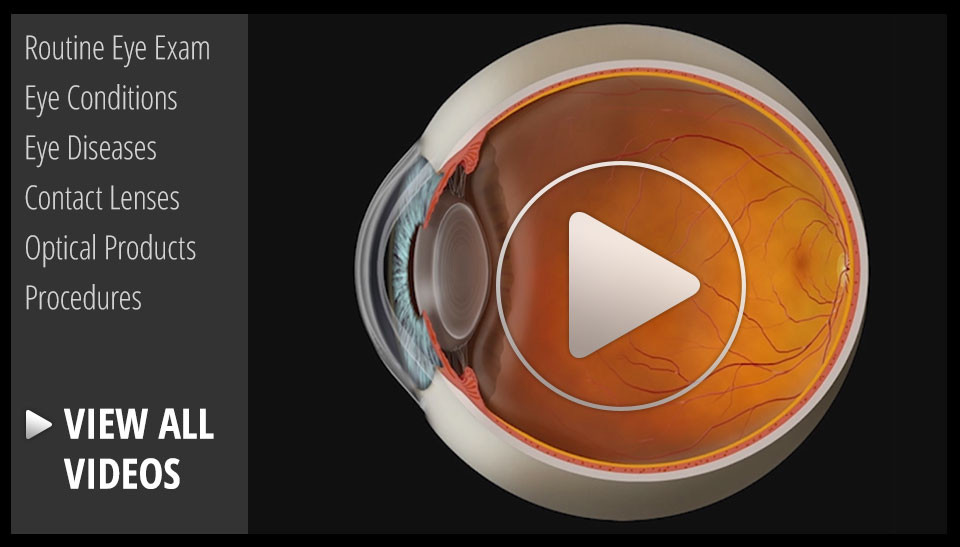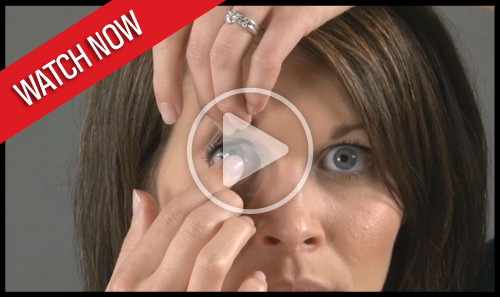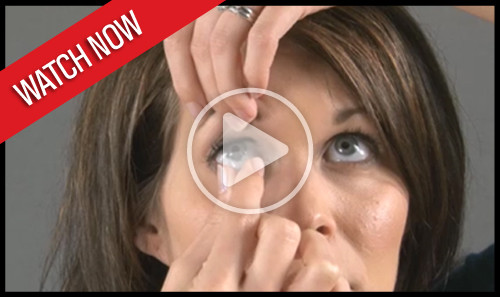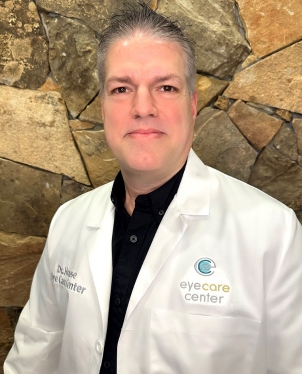
Dr. Jon House was born and raised in Three Rivers, TX. He earned a Bachelor of Science degree in Psychology with a minor in Biology from Texas State University in 2001. His interest in eye care was sparked while working at a large eye care clinic during his undergraduate career. Subsequently he graduated Magna Cum Laude from the University of Houston College of Optometry with a Doctorate of Optometry degree in 2009. During his time at Houston he became a published scientific author and received many accolades as a student clinician.
After graduation Dr. House became a licensed therapeutic optometrist practicing for two years in Texas City, TX. As one of the only trained eye care specialists in the heavily industrialized area, Dr. House gained great experience with ocular emergency treatment as well as general eye care.
In late 2011, Dr. House had an opportunity to purchase the Texas State Optical practices in Bryan/College Station. As a practitioner he quickly became recognized for providing comprehensive eye care that emphasized personalized service. His belief that understanding his patients beyond just their basic vision needs was well received in the Brazos valley and he successfully practiced for the next 10 years.
After a 5 year hiatus Dr. House is excited to be practicing in the area again and to join Eye Care Center where he intends to provide comprehensive and outstanding eye care to the Brazos Valley community.
Dr. House and his wife Jennifer have now lived in the area for thirteen years and have three children. His eldest, Danielle, is a member of the Fightin’ Texas Aggie Class of 2027. His daughter Avery has been heavily involved in ballet and his son Cullen has been invested competitively on a national level in taekwondo. They have all kept Dr. House very busy the last five years but he is ready to serve his community once again.
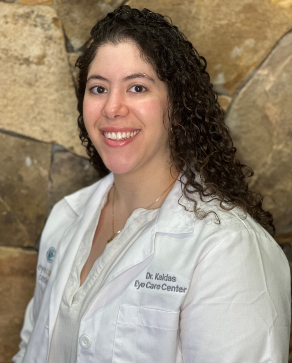
Dr. Isis Kaldas was born in California, but as a Navy brat spent most of her childhood in Italy. Her family then retired to Jacksonville, FL, where she attended the University of North Florida and obtained a Bachelors of Science in Chemistry with a minor in psychology. She then moved to San Antonio, TX to attend optometry school at the University of the Incarnate Word - Rosenberg School of Optometry. She spent her externships with an ophthalmology group and was able to observe and manage refractive, retinal, and cataract surgeries. She was also able serve a lot of our Vietnam veterans at the Fayetteville, NC VA.
After graduation she completed her residency at the Bay Pines VA in Bay Pines, FL specializing in ocular disease, low vision, and specialty contact lenses. She then moved back to San Antonio and worked for several years at a private practice before moving to Amarillo, TX. After several more years, she and her family decided to move to be closer to family and friends. Now they are fortunate to call College Station home.
Dr. Kaldas loves providing primary eye care, managing glaucoma, and co-managing refractive and cataract surgeries. She especially loves fitting contact lenses.
In College Station she and her family enjoy spending time at church and especially serving the youth. She also enjoys taking walks, hiking, and cooking in her spare time. And of course watching Texas A&M football! They often travel to see family and spend time with cousins. She is married to a proud Aggie husband, and they have one little future Aggie.
Please visit our facebook page (Facebook.com/EyecareBCS) for up to date information on our hours. If you do not have access to Facebook, please call us at 979-779-9000. If we are closed we will try to have updated hours or status on our voicemail. You can also text for specific questions or concerns to our main phone and we will get back with you as soon as possible. Thank you for your patience in working through all of this with us
Please print form and send via email
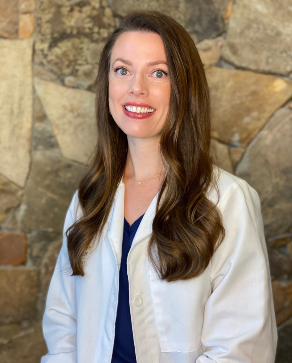
Dr. Abby Zike was born and raised in Lincoln, Nebraska. She graduated from Nebraska Wesleyan University before moving to Texas to pursue her Doctorate of Optometry at the University of the Incarnate Word – Rosenberg School of Optometry. She now practices as a licensed Therapeutic Optometrist and Optometric Glaucoma Specialist in the Bryan/College Station area. She did her clinical externships at a medically-based, private practice in San Antonio as well as Lackland Air Force Base, where she had the privilege of treating current and retired military members, and their families. Through these rotations, she had extensive training in the management of ocular disease including glaucoma, diabetic retinopathy, dry eye and ocular surface disease, keratoconus, and various ‘red eye’ cases. She has significant experience in the fitting and evaluation of various types of contact lenses, including specialty lenses, such as scleral lenses, and ortho-keratology lenses. She is passionate about fitting scleral and other specialty contact lenses, and recognizes the rewards that can come from such fits, especially when patients have struggled with vision due to keratoconus or other corneal conditions. Dr. Zike is a member of the American Academy of Orthokeratology and Myopia Control. She thoroughly enjoys seeing patients of all ages, and delivering compassionate and quality eye care.
She is very excited to call the Bryan/College Station area her home and to provide comprehensive eye care to the community! While she loves her home state dearly, she is also a proud ‘transplant’ Texan, and has even started using the word ‘y’all’ in her daily vocab! Her and her husband are beyond blessed as the parents to toddler twin girls, Liliya (Lily) and Camilla (Millie).  They are the loves of her life and inspire her in all that she does. She is also overjoyed to be an aunt to her nephews and nieces! In her free time, Dr. Zike enjoys spending time with her husband, family and friends, travelling... usually to visit family, watching a baseball game (Go KC Royals!), or eating wings with Nebraska or Texas A&M Football playing!
They are the loves of her life and inspire her in all that she does. She is also overjoyed to be an aunt to her nephews and nieces! In her free time, Dr. Zike enjoys spending time with her husband, family and friends, travelling... usually to visit family, watching a baseball game (Go KC Royals!), or eating wings with Nebraska or Texas A&M Football playing!
Eye Care Center in Bryan / College Station proudly carries the largest adult & children’s frame selection in the Brazos Valley. Our frames offer abundant color and material options, sophisticated, traditional, or more edgy designs, and even lenses personalized with your initials engraved inside your glasses! Some popular brands include:
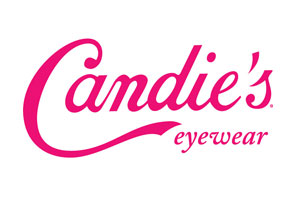


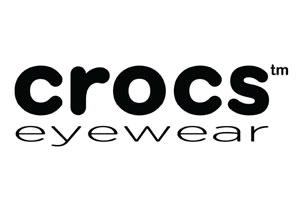




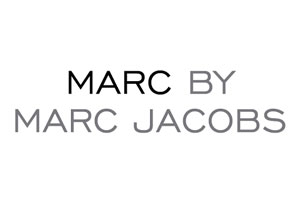




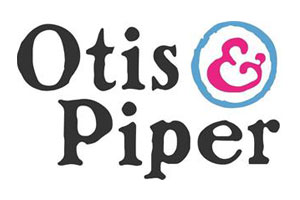

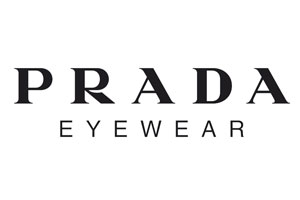
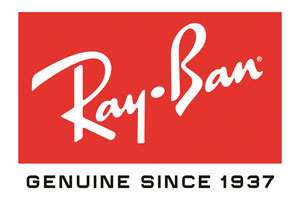

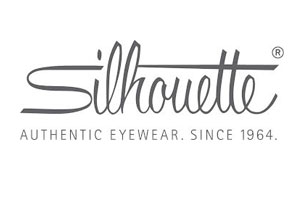
Many times when someone does not have vision insurance OR if vision insurance does not cover the exam, medical insurance may. If you experience burning, itchy, dry eyes or if you have cataracts or other eye related medical problems, your medical insurance may be billed for your exam. In these cases, you will often only owe a co-pay. Please provide policy information at the time you schedule your appointment.
If you do not have medical or vision insurance, our office invites you to take advantage of a 20% frame and 20% lens discount!
As always, if you have any insurance or billing questions please do not hesitate to email us at
Not all plans listed are accepted at the Navasota practice - please contact us if you have any questions.
Accepted Insurance
Medical Plans
- Administrative Concepts
- Aetna
- Avesis
- AVMA
- Blue Cross Blue Shield
- Beech Street
- Boon-Chapman
- Coventry
- First Care
- First Choice Health
- First Health
- Galaxy
- Golden Rule
- GPA
- Great West
- Health Smart
- Humana
- Medicare
- Muliplan
- Mutual of Omaha
- Pacificare Signature Elite
- PHCS
- Principal Financial Group
- Scott and White Health Plan (services component)
- Texas True Choice
- Tricare
- UMR
- Unicare
- United Healthcare (Medical component)
Vision Plans
- Cigna Vision
- Guardian
- Superior
- VSP
Checklist for the day of your Appointment
Curious what to bring to your eye exam with Dr. Dobson?
- Your smiling face: We look forward to meeting you for the first time, or if we have the pleasure of seeing you again, welcoming you back! Remember to allow about 1.5- 2 hours for your experience with us. Taking care of you takes time and we don’t want you to feel rushed. We are very efficient and prompt, but we are not a “Doc-in-a-Box” and we don’t take short cuts in providing your care. We respect your time and value your trust in us. It’s our passion and we think you’ll see that from the minute you arrive.
- An adult: If you are under the age of 18, bring an adult to consent for us to examine your peeps. However, if your parent/guardian needs to drop you off and pick you up after your appointment, we accommodate these circumstances as well.
- Photo I.D. Card: Most use their drivers license or school photo I.D.
- MEDICAL & VISION insurance cards: Yes, we need both. Many times patients are surprised at the routine coverage on their medical policies, and we confirm these benefits free of charge so you don’t have to! For your vision insurance, don’t panic if you can’t find your Eyemed, Superior Vision, or Vision Service Plan (VSP) eye insurance cards. We can access your coverage online as a courtesy.
- Medications: Its helpful to have a list of your medications, both prescription and non-prescriptions. Don’t forget to include eye drops and vitamins.
- Eyeglasses: Whether you love or despise your old glasses, bring them to us so we can obtain a prescription reading on them. While they are not necessary for us to complete your eye exam, it is helpful to know your old prescription so Dr. Dobson can educate you on the changes in your prescription, if any.
- Over-the-counter Reading glasses: Yes, we need these too! We want to see the powers you are accustomed to wearing.
- Previous Contact Lens Info: Grab your old boxes and we can do the rest. Written prescriptions work too! Whatever is easier for you. This information is helpful because if you dislike your current contacts, we would love to know which brand/power you are wearing, as to create a completely different wearing experience.
- Sunglasses: Proper UV protection is crucial for the eyes. It’s like wearing sunscreen when fighting the brutal Texas sun. Don’t leave them in the car, but rather let our eye care professionals examine your sunglasses to ensure you are properly covered.
- Your Smart Phone: We love patients to interact with us on social media. Go ahead, get it out, like us on Facebook or follow us on Twitter, Linked IN, or Pinterest. We understand our phones are our life-line these days, so feel free to bring it. We just ask that you not text or talk on the phone in the middle of your eye exam with Dr. Dobson.
- Records: In most cases, Dr. Dobson does not need your previous medical record. However, there are times where this information is valuable.
WE HAVE MOVED!! March 2018 was a big month for us here at Eye Care Center. Our previous location was in Bryan, TX near St. Joseph's hospital at 2320 East Villa Maria. Now, our new home is conveniently located in South College Station, Texas near HEB in the TowerPoint area right off Highway 6 and William D Fitch. Our new address is 903 William D Fitch and we are located approximately 0.5 miles west of Highway 6 on William D Fitch between Bahama Bucks and Taco Bell.
At Eye Care Center, our professional eye care staff will be happy to assist you with your vision needs. we pride ourselves in providing the utmost quality care, complete with the latest advancements in technology. Our sleek new cutting edge facility is now equipped with the highest level medical and optometric equpiment to provide treatment options available for everyone. Whether you are interested in making an appointment for a LASIK consultation, have cataracts, need an annual eye exam, or just need glasses, we can help! You may TEXT or call (979) 779-9000 with eye exam appointment requests for Dr. Belinda Dobson, OD or Dr. Abby Zike, OD.
Contact us today using the forms below, or call us directly at (979) 779-9000.
If so, click Here for more info
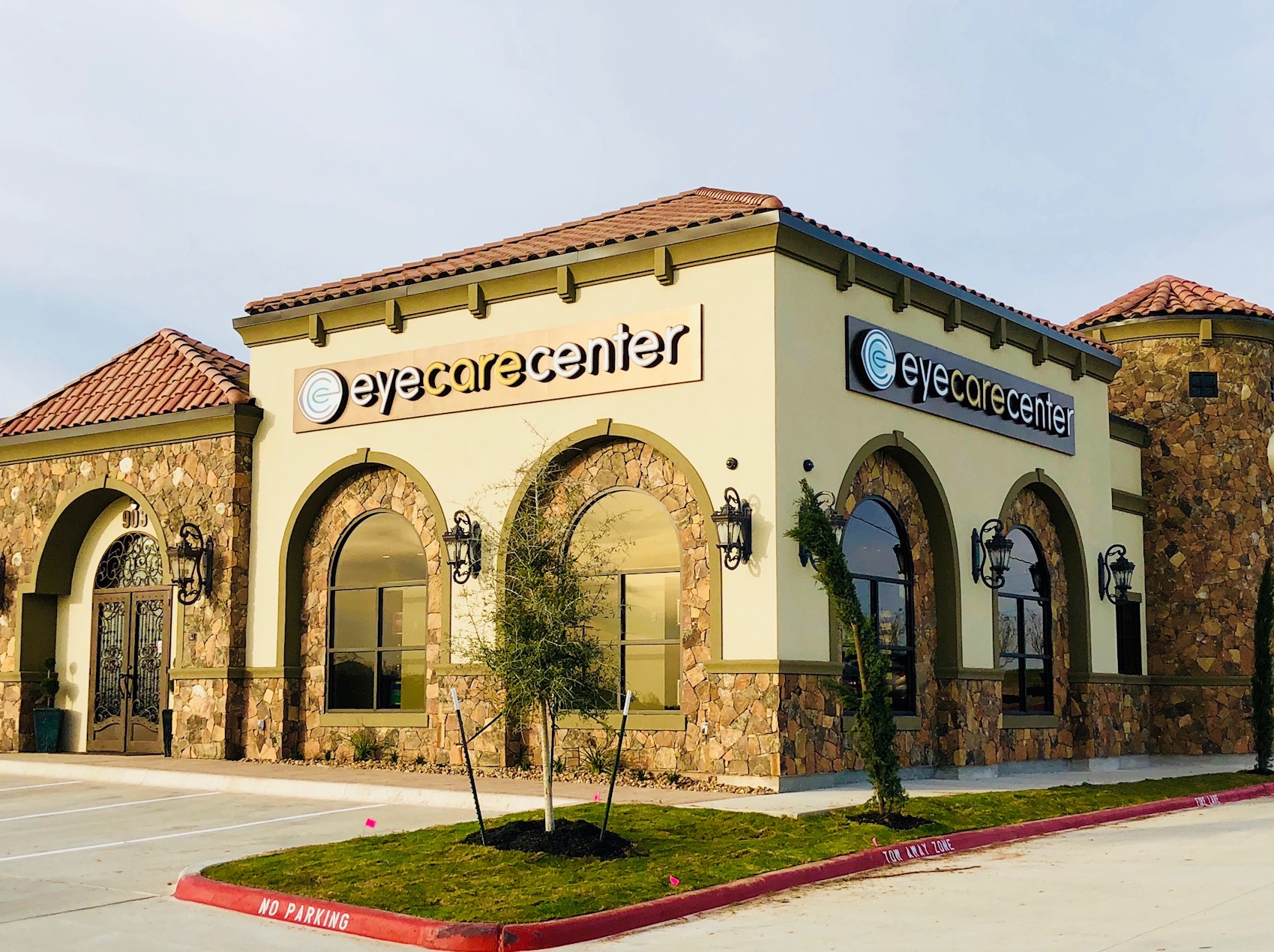
To Our Loyal Friends and Patients of Navasota and surrounding Grimes County,
First of all, welcome back to our website! Allow me to thank you for your patronage and your loyalty over the years. As you have probably heard by now, we made a difficult decision to consolidate the Navasota Eye Care Center & Eye Care Center in August 2014. I would love nothing more than to welcome you back for your all your eye care needs.
Personally and professionally, opening a satellite practice in Navasota was one of the most rewarding experiences I’ve had to date. Reflecting upon the our time in Navasota, we have developed many relationships, shared lots of laughs, and enjoyed getting to know each and every one of you. As your eye doctor, my passion is deeply rooted in a commitment to provide you exceptional service, quality products, and an experience second to none. Our patients are our top priority.
As most of you know, our primary practice is located in Bryan/College Station. Both practices have grown exponentially thanks to your continued business and kind word-of-mouth referrals. Our vision has never been stronger or more precisely focused than today.
We must face the simple fact that our growth has exceeded our ability to ‘be in more than one place at one time.’ In consolidating our locations, we offer you more appointment options (including walk-in’s), a renovated optical with increased selections, and premier advancements that bring you the most state-of-the-art technology in the entire Brazos Valley.
When its time for your next eye appointment, call the same phone number (936) 825-CARE or schedule online at www.NavasotaEye.com. The same friendly staff, dedicated eye doctor, and welcoming environment will be right up the road! We maintain your medical records, prescriptions, etc, etc. There is essentially no change other than the physical location with a better opportunity for service.
Many a thanks for you for a great two years, and we are excited to see what our future holds! A special thanks is due to the doctors and staff of Navasota Medical Center for their hospitality and friendship. Navasota, you are fortunate to have such a great team of doctors here locally. We proudly continue to work with them closely to ensure you receive the best care possible.
Until next time,
Belinda Dobson, O.D.
Eye Care Center
Since its inception in 1983 by Dr. Sue Simpson, O.D., Eye Care Center has always been committed to quality eye wear, top-notch eye exams, and exceptional patient satisfaction. In 2008, ownership of Eye Care Center was transferred to Dr. Belinda Dobson, O.D. of College Station Texas. Dr. Dobson’s focus was centered on driving further advancements in technology, as well as eye disease diagnosis, management, and treatment. This leadership and passion allows Eye Care Center to remain ‘ahead of the curve’ through each evolving decade. Proudly Aggie owned and operated, Eye Care Center continues to provide the very best eye exams, eye glasses, and contact lenses to the Bryan / College Station communities, as well as surrounding areas such as Anderson, Caldwell, Hearn, Navasota, Normangee, North Zulch, and a long list of others!
In 2002, Eye Care Center was invited into an elite network of eye doctors called Vision Source. Vision Source eye doctors are a group of premier private practice eye doctors who are uniquely identified as the “cream of the crop” in eye care. These doctors of optometry are highly trained individuals who dedicate their practices to maintaining the latest and greatest in technology, possess advanced knowledge, skills, and expertise to diagnose and treat numerous eye diseases, and value patient relationships and education above all else. Our vision source doctors are therapeutic optometrists, meaning they have exceeded basic optometric training in order to better serve the needs of their patients. For more information about each of our optometric physicians, please click HERE.
Eye Care Center’s commitment to community, professionalism, and superior personal service drive our core values. We are inspired experts who eagerly aim to delight our patients with supreme care every day. We provide only the highest quality lenses and eyewear, the most state-of-the-art diagnostic technology, and the very latest in contact lens advancements. Our highly trained eye care professionals dedicate each day to exceeding the expectations of every patient and their needs, ensuring an experience for which you’re guaranteed to see the difference.
We love our patients and our patients love us! While most patients have a five-star experience, sometimes we meet patients who show us opportunities for growth. Because we value your opinion and yearn to provide consistent, world-class service, we invite every patient to review us online after his or her appointment and/or eyewear experience. We read every review and adapt accordingly so we may radically exceed patient expectations and provide the best customer service possible.
Click HERE to read patient reviews, which are confirmed and certified as true Eye Care Center patients, or HERE to see what our patients are saying about us on Google. Facebook is also a common area patient like to show us love.
These days, we place so much faith in online reviews to give us ideas of product and service expectations. At Eye Care Center, our patients are invited to review us on Google and Demand Force following their experience with us. We love this method because these are truly our patients and their experiences. CLICK HERE to read these reviews. Our management and doctor read every review and utilize it to provide an even better service to our patients.
Every comprehensive eye exam includes a vision analysis, an ocular health check, and an eyeglass prescription at no additional charge. These eye prescriptions can be as generalized or specific as you need. Just like you wouldn’t wear your high heals to the gym, “everyday” glasses don’t always provide the best results for certain tasks or hobbies.
We enjoy customizing glasses to help you perform at 100%. Such lenses include: driving glasses, computer glasses, golf glasses, reading glasses, safety glasses, shooting glasses, sunglasses, and the list goes on and on. You name the task and we can create the lens to help you be on your “A Game!”
Sometimes glasses are not the best option. Whether you just don’t like glasses, or you work outside and the demands of your job put you at a safety risk, we can offer other alternatives. For these patients, contact lenses provide great solutions. Whether you’ve worn contacts before or this is all new to you, we help you through every step of the way.
Contact lenses offer such convenience, flexibility, and versatility. Regardless of your previous experience with glasses or contacts, our eye doctor and professionals take pride in helping patients successfully wear contact lenses for any occasion.
So you say, “But I have been told by my last eye doctor I can’t wear contacts?” While some patients are truly not candidates, Dr. Dobson’s skills and technology awareness allow her to utilize different, more “cutting-edge” contacts to “wow” those who have not tolerated contacts well in the past.
During your eye exam, Dr. Dobson will determine if you qualify for a contact lens fitting. Your glasses prescription is determined during the eye exam and is used to customize an initial contact lens prescription. We stock thousands of lenses so in most cases you leave the office the same day with your free contact lens trials. If you have never worn contacts, our trained professionals will spend quality time teaching you the proper methods for insertion and removal, as well as how to care for the contacts. When possible, we select daily contact lens. These lenses are voted the most convenient and comfortable lenses on the market. Studies prove these daily contacts are the safest contacts, and the fastest growing lens in the world.
Not sure you can wear contacts but still want to try it? No problem. We have a “no strings attached” policy. This means that after you engage in the contact lens fitting process, you are not obligated to purchase contacts lenses if you change your mind or are unable to wear them successfully. This allows you to try them out without purchasing contacts. The trial lenses are always free during this fitting process. Click HERE to hear more about contact lenses.
Our professionals at Eye Care Center make every effort to accommodate your eye appointment requests. We have extended hours on Mondays for those who need to have an eye exam after work. For your convenience, you can begin scheduling online by clicking HERE. If you do not see the time you need, feel free to call us at (979) 779-9000 and we may still be able to work with your schedule.
To expedite your eye exam, please complete your patient interview before your appointment. This may be completed in the comfort of your own home, or “on-the-go” from your smart phone. The link is secure and forwards all information directly to your own patient chart.
Common questions we hear from patients are…
-
Are you taking new patients?
Are you taking new patients?
OF COURSE! We absolutely take new patients. We welcome any and all new faces to Eye Care Center.
-
Do you do kids eye exams?
Do you do kids eye exams?
YES, we perform children’s eye exams. Kids are some of our favorite patients because most of us are moms. We make every effort to make your babies feel welcome and most importantly, have fun! We even have a special treat for kids who love dogs. Our Eye Care Center mascot is a Golden-Doodle dog named Laci! She is a service dog who helps ease the nerves or fears of patients, specifically with dilation. Meet Laci now by clicking HERE.
-
Can our family come in at the same time?
Can our family come in at the same time?
Absolutely! We want to help you maximize your time. We accommodate families and can see everyone at the same time. Let us help you manage your time wiser. Schedule everyone an appointment today by clicking HERE.
-
Do you take XYZ insurance?
Do you take XYZ insurance?
We take most medical and vision insurances. When you schedule your appointment, have your cards handy. Our staff will ask for pertinent information from your cards. Our insurance specialist will verify your insurance before your appointment as a courtesy to you. For a complete list of all insurance we accept, Click HERE. Don’t forget your medial insurance. Most of the time, medical insurance can either be used for (1) Routine coverage—Many times it can be more cost effective for you than even your dedicated vision insurance, or (2) Medical coverage—In the event your exam turns medical, we like to have this information to provide you the best of care.
-
Can you examine someone in a wheel chair?
Can you examine someone in a wheel chair?
Yes! Our exam rooms are equipped with a handicapped feature to allow your loved one to remain in his or her wheel chair throughout the duration of the eye appointment. Let us know at the time of your appointment, so we may allow for extra time if needed.
From the moment you arrive for your office visit, YOU are our number one priority. We schedule ample time for your appointment so you will never feel rushed or hurried. Our desire is to make certain you have all of your questions and concerns addressed in our office before you leave. The most common comment we hear is, “Wow, I’ve never had an eye exam like that before!” The time and compassion every member of our staff offers makes for a world-class experience.
This level of care takes time! We ask you allow approximately 2 hours for your appointment. If you have a meeting or something you need to run off to, please let our receptionist know and we will accommodate your visit to the best of our ability. You will spend the first part of your eye exam with a highly trained optometric technician, where he/she will conduct your welcome interview and case history including allergies, medications, and your medical health history. The technician will also acquire pertinent data from Dr. Dobson, including visual acuities, blood pressure, intraocular eye pressure, high definition retinal photography (Optomap Retinal Imaging, eye muscle alignment, color vision, and peripheral vision screening. All the while, the technician will educate you on the process. In most cases, we can avoid dilation of your pupils by utilizing the Optomap high definition retinal camera, but in the event you need to be dilated, we do offer a reverse dilation drop.
Dr. Dobson will review your medical record prior to visiting with you in the exam room. She is equipped with the VERY BEST technology and skill set to identify multiple eye and visual pathway anomalies, but also to screen healthy eyes and obtain the best set of baseline diagnostic data that proves useful for years to come. She really takes the time to answer any and all questions, and its important to her you leave Eye Care Center more informed and with a better understanding than when you arrived.
After your comprehensive eye health exam and vision analysis, you will be escorted to the frame bar by your own personal Eye Care Center Optician, who will assist you in shopping for the most comfortable, stylish, and customized eyewear for you and your sense of style. Your concierge optician will also tailor your eyeglass lenses to the frame you pick, use laser technology to obtain precise measurements of the glasses as you wear them, and complete your experience with an estimated quote on a ship date for your new eyewear. In many cases, we offer same day or “one-hour glasses” as a courtesy for patients who need same-day service. In other cases, premium eyeglass lenses do take time to custom design. It is in this digital technology and cutting-edge customization where we truly shine. The craftsmanship and attention to detail in your optical experience is a high priority for everyone at Eye Care Center.
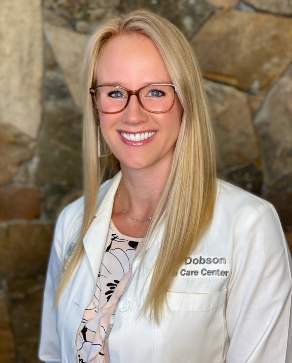
Dr. Belinda Dobson, O.D. is a member of the Fightin’ Texas Aggie Class of 2003! She graduated Texas A&M University with a Bachelor of Science degree in Biology.
While at A&M she held numerous community/leadership positions in organizations such as Alpha Epsilon Delta (pre-medial honors society), Phi Eta Sigma Academic Honors Society, Big Event, and student government.
In her spare time, Dr. Dobson also competed in NCAA Archery for Texas A&M University and volunteered at the Health Department providing health and vision screenings.
After college, Dr. Dobson attended 4 more years at the University of Houston, College of Optometry, where she earned her Doctor of Optometry Degree. She now practices as a licensed therapeutic optometrist and glaucoma specialist in Bryan, Texas. Her externship training was in Plano and Cleburne, Texas, both very medically driven practices. These sites allowed her to gain the superior knowledge and skills to treat a variety of pathologies such as dry eye, keratoconus and other corneal diseases, and a host of other complicated ocular abnormalities.
The Vision Care Institute in Jacksonville, Florida has also recognized Dr. Dobson as a specialist in contact lens fitting for astigmatism and bifocal/multifocal contact lenses. Her extensive training and background in contact lens serves as her foundation for successfully fitting the most challenging contact lens patients. Dr. Dobson enjoys these patients the very most, as these are usually the patients other doctors have told they will never successfully wear contact lenses. These experiences are especially rewarding!
 In addition, Dr. Dobson specializes in the management of cataract surgery; including the laser cataract surgery as well as premium bifocal cataract implants, which often require no glasses or contacts after surgery. She also co-manages refractive surgery cases such LASIK, ICL, and PRK. Some of her other passions include diagnosis and management/treatment of ocular conditions such as corneal foreign bodies, dry eye, eye infections, glaucoma, diabetes, and macular degeneration.
In addition, Dr. Dobson specializes in the management of cataract surgery; including the laser cataract surgery as well as premium bifocal cataract implants, which often require no glasses or contacts after surgery. She also co-manages refractive surgery cases such LASIK, ICL, and PRK. Some of her other passions include diagnosis and management/treatment of ocular conditions such as corneal foreign bodies, dry eye, eye infections, glaucoma, diabetes, and macular degeneration.
Dr. Dobson’s professional affiliations include: Better Business Bureau, Lions Club of Navasota, both Bryan/College Station and Navasota Chambers of Commerce, American Optometric Association, Texas Optometric Association, Vice President of Aggieland Professionals, and secretary of Brazos Valley Optometric Society. Community involvement includes: Volunteer with BCS Foodbank , Bargain Blitz, and Stuff the Bus, as well as BCS Junior League. Dr. Dobson and her family attend Brazos Fellowship and love the Lord!
Outside work, Dr. Dobson and her husband Josh are co-owners of quite possibly the largest tailgate at Texas A&M University, SNAKEBITE TAILGATE, awarded “2014 Tailgate of the Year.” Football weekends are full of hosting patients, friends, families, and even “the other team” at times. It’s fun for the whole family! And finally, most importantly, Dr. Dobson is the mother of two precious kiddos, Chelsea Jo (13) and Gage (10). They keep her on her toes and keep life full of excitement!
Welcome to Eye Care Center
Providing you excellent service and quality you can see.
Since 1983, our optometric practice has been proudly serving College Station - Tower Point, Bryan, TX and surrounding communities with excellent service and a friendly staff.
From the moment you arrive for your visit, YOU are our number one priority. We schedule ample time for your appointment so you will never feel rushed or hurried. The desire of Dr. Belinda Dobson, Dr. Abby Zike, Dr. Isis Kaldas, and Dr. Jon House is to make certain you have all of your questions and concerns addressed in our office before you leave.
The most common comment we hear is, “Wow, I’ve never had an eye exam like that before!” The time and compassion every member of our staff offers makes for a world-class experience.
Our team also pays attention to the details and this ensures your time with us is efficient, enjoyable, and informative. Dr. Dobson’s leadership at Eye Care Center drives a unified team-approach that breeds exceptional customer service during every part of your eye exam. Our passion is simply providing exceptional customer service.
Finally, our team of eye care professionals wants to get to get to know you! Our belief is that if we truly get to know our patients and what makes them happy, we can visually accommodate them in every stage of life. It’s the perfect balance of the “science ” and the “getting to catch up with an old friend.”
See our location featured in a major optometric publication
From the moment you arrive for your visit, YOU are our number one priority. We schedule ample time for your appointment so you will never feel rushed or hurried. The desire of Dr. Belinda Dobson, Dr. Abby Zike, Dr. Isis Kaldas, and Dr. Jon House is to make certain you have all of your questions and concerns addressed in our office before you leave. The most common comment we hear is, “Wow, I’ve never had an eye exam like that before!” The time and compassion every member of our staff offers makes for a world-class experience.
Our team also pays attention to the details and this ensures your time with us is efficient, enjoyable, and informative. Dr. Dobson’s leadership at Eye Care Center drives a unified team-approach that breeds exceptional customer service during every part of your eye exam. Our passion is simply providing exceptional customer service.
Finally, our team of eye care professionals wants to get to get to know you! Our belief is that if we truly get to know our patients and what makes them happy, we can visually accommodate them in every stage of life. It’s the perfect balance of the “science ” and the “getting to catch up with an old friend.”
Welcome to the Eye Care Center video learning center! Please call our office at (979) 779-9000 if you have any questions about the conditions you see here.
Our YouTube Channel
WE HAVE MOVED!! March 2018 was a big month for us here at Eye Care Center. Our previous location was in Bryan, TX near St. Joseph's hospital at 2320 East Villa Maria. Now, our new home is conveniently located in South College Station, Texas near HEB in the TowerPoint area right off Highway 6 and William D Fitch. Our new address is 903 William D Fitch and we are located approximately 0.5 miles west of Highway 6 on William D Fitch between Bahama Bucks and Taco Bell.
At Eye Care Center, our professional eye care staff will be happy to assist you with your vision needs. we pride ourselves in providing the utmost quality care, complete with the latest advancements in technology. Our sleek new cutting edge facility is now equipped with the highest level medical and optometric equpiment to provide treatment options available for everyone. Whether you are interested in making an appointment for a LASIK consultation, have cataracts, need an annual eye exam, or just need glasses, we can help! You may TEXT or call (979) 779-9000 with eye exam appointment requests for Dr. Belinda Dobson, OD or Dr. Abby Zike, OD.
Contact us today using the forms below, or call us directly at (979) 779-9000.
If so, click Here for more info


We feel it is important that you understand that when it comes to vision care products, they are not all created equally! Across the eye care industry there is a large variance in quality and craftsmanship. We take pride in using a wide-range of top quality materials with great product support to provide you with the best possible eye care products. We meet regularly with manufacturer's representatives to make sure that we have the latest and greatest available. Our value is in knowing what is available and what best meets your needs.
When considering where to purchase your eyeglasses, contact lenses, and sunwear, remember to consider the following. . .
Total Eye Health
Our office is part of this community. We want you to have sharp vision and great comfort with your glasses and contact lenses. The health of your eyes is our major concern. That is why we stand behind our products and services with unique warranties, and a professional and well-educated team. Different prescriptions require certain frame styles and lens treatments in order for your glasses to perform well and look great. Our trained opticians can guide you through this process. Our dispensary has hundreds of frames from which to choose, including a large selection of children's frames. We can help you find the size, shape and color of frame that is perfect for all family members. When it comes to contact lenses we offer a full spectrum of the latest and best performing products. Even if you have been told before that you cannot wear lenses, we may have a solution that is right for you.
Competitive Pricing
At Eye Care Center we offer competitive pricing, affordable eyewear packages, and multiple pair savings. You are also welcome to take advantage of manufacturer rebate programs and special promotions through our office. Be sure to ask about our convenient contact lens direct shipping program.
Convenience
Your Eye Care Center offers a wide selection of products in our office as well as through custom orders. We use only the highest quality materials and will courteously recommend eyewear and contact lenses that fit your lifestyle and fashion - all within your budget.
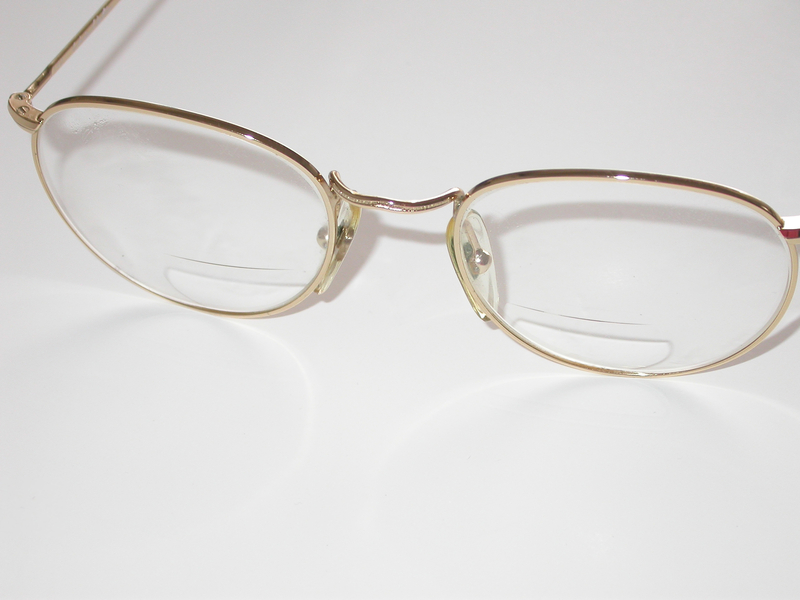
For many people, different lenses are needed for seeing at different distances. Bifocal lenses allow the wearer to look through two areas of the lens. One area focuses on distant objects. The other is used for reading. A little-known fact is that bifocals were invented by Benjamin Franklin, and his style of bifocals are still available today.
Most of the time the “reading” area is smaller, shaped like a sideways “D”, and found in the lower hemisphere of the lens. These bifocals are called line bifocals or flat-tops. If you are focusing on distant objects, you look through the top half of the lenses. To read a book, magazine, or newspaper, you look through the “reading” area. The Franklin style lenses are less common, and are split horizontally down the middle of each lens. One thing that is difficult about using bifocals is dealing with the line between the two vision areas. Fortunately, recent technologies have developed a new type of lens, called the no-line, or progressive, lens.
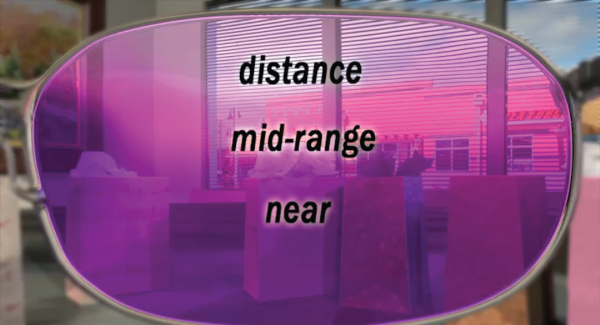
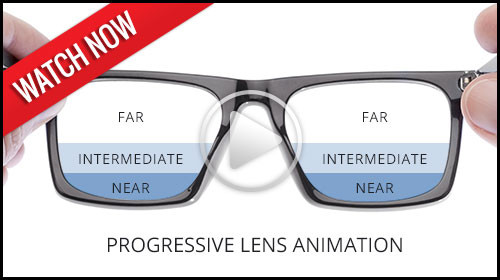 One of the main problems with bifocal and trifocal lenses is the problem of eye fatigue. It is difficult to switch from one focusing power to another. It can make your eyes tired, and it can even lead to a headache, sore neck and sore back.
One of the main problems with bifocal and trifocal lenses is the problem of eye fatigue. It is difficult to switch from one focusing power to another. It can make your eyes tired, and it can even lead to a headache, sore neck and sore back.
A recent variation of bifocals and trifocals is the no-line lens or progressive lens. No-lines provide a smooth transition from focusing on nearby to focusing on distant objects because they do not have a distinct line which separates the focusing powers. Instead, a gradual change in power allows the wearer to focus on objects at all distances. Distant objects are viewed through the upper portion of the lens, while near objects are viewed through the middle or lower portion of the lens. These are also great for computer users.
Bifocals allow the wearer to read through one area of the lens, and to focus on distant objects through another area of the lens. As the eyes age, though, a stronger prescription is often needed to read. This would be fine, but the stronger prescription that allows for reading makes it difficult to focus on objects at intermediate distances, such as grocery items on a shelf or your speedometer. Thus, trifocals are necessary for a third prescription for intermediate focusing.
Trifocals, also known as line trifocals, feature three areas of focusing power, each separated from the other by a distinct line. The three windows allow for focusing on distant objects, intermediately distanced objects, and for reading. The downside of trifocals is dealing with the lines between the different focusing powers. Fortunately, recent advances in technology have led to developments in no-line, or progressive lenses.
Previous to the last few years, the only materials available for use as lenses were glass and a hard resin called CR-39. But recently, high index lenses have become available. High index materials are named because they have a higher index of light refraction. Basically, they can do the same job that glass or CR-39 does, but high index lenses are much thinner and lighter. With high index lenses, you can avoid having “soda bottle” lenses.
When learning about high index lenses, you may hear many unfamiliar numbers and terms. Here are a few things to remember.
Polycarbonate
The first and still the most popular high index plastic is polycarbonate. Polycarbonate was originally developed for fighter jet cockpits. It is very strong, very light, and resistant to scratches and breaking. Most sports lenses are made of polycarbonate.
Mid-Index
Other high index materials are classified by numbers. The higher the number, the thinner and lighter the lens. The lower numbers are classified as mid-index lenses. Mid-index lenses, such as 1.54, 1.56, and 1.57, are thinner than glass, and nearly as strong as CR-39.
High-Index
High index lenses are much thinner than regular glass or plastic. Talk with Dr. Belinda Dobson or your Eye Care Center Optician to decide which high index lens is right for you.
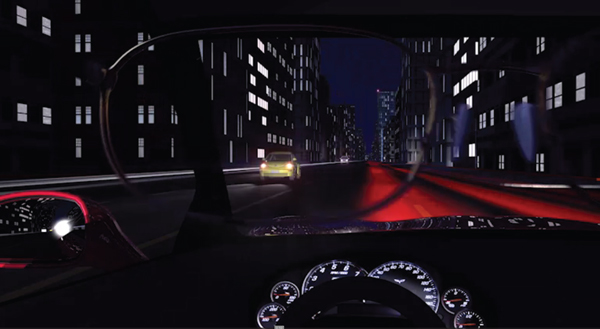
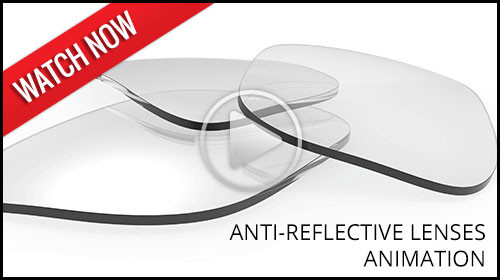 Normal eyewear often creates glare, reflections, and “ghost images.” Now all that can be eliminated with an anti-reflective coating.
Normal eyewear often creates glare, reflections, and “ghost images.” Now all that can be eliminated with an anti-reflective coating.
What we see is a result of light being sensed by our eyes. With normal glasses, much of the light reflects off the lenses. This produces glare. It also reduces the wearer’s visual acuity. In other words, the light reflection is both a cosmetic and visual problem.
Anti-reflective coatings increase light transmission through the lenses to 99.5 percent. They make it easier to see and easier for others to see you. These coatings are especially useful for those viewing computer screens and driving at night.
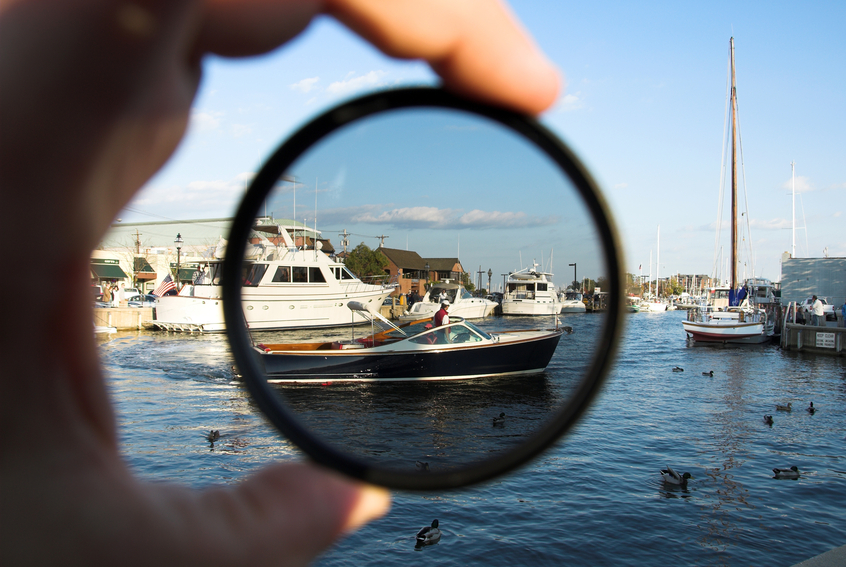
 Glare from wet roads, light reflecting off other vehicles, and glare from your own windshield can be annoying and dangerous. To eliminate this glare, we offer polarized lenses. Polarized lenses eliminate almost all glare, reducing eye strain and increasing visibility. Polarized lenses are the most effective way to reduce glare.
Glare from wet roads, light reflecting off other vehicles, and glare from your own windshield can be annoying and dangerous. To eliminate this glare, we offer polarized lenses. Polarized lenses eliminate almost all glare, reducing eye strain and increasing visibility. Polarized lenses are the most effective way to reduce glare.
Most glare comes from horizontal surfaces, so the light is “horizontally polarized.” Polarized lenses feature vertically-oriented “polarizers.” These polarizers block the horizontally-polarized light. The result is a glare-reduced view of the world. Polarized lenses can make a world of difference for any outdoor enthusiast. Fisherman can eliminate the bright reflections from the water and actually see into the water more easily than with other sunglasses, golfers can see the green easier, and joggers and bikers can enjoy reduced glare from the road. In addition, drivers can enjoy the safety and comfort that polarized lenses provide while driving.
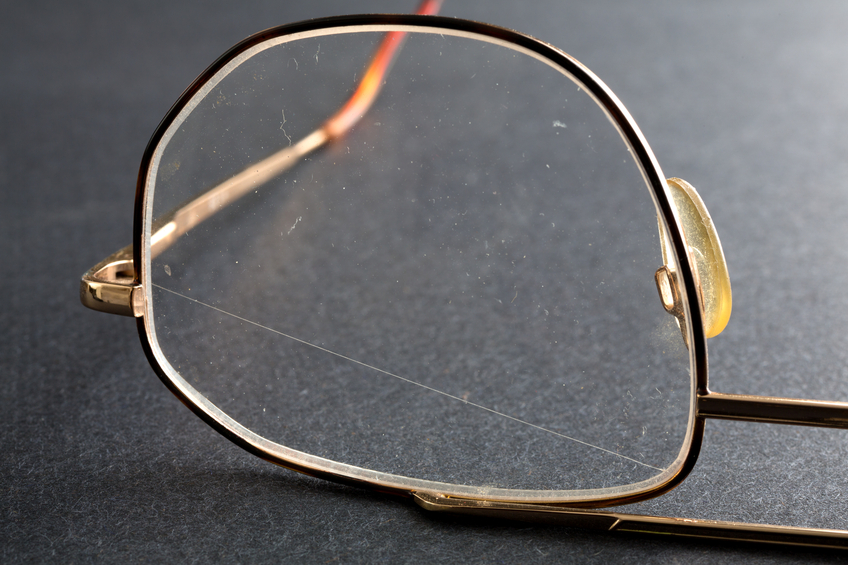
If you have hard resin lenses (CR-39), you should consider getting a scratch resistant coating. Resins and plastics are more susceptible to scratches than glass. Scratches damage the cosmetic look of the lenses and compromise their performance. With a scratch resistant coating, you do not have to worry as much about minor scratches on your lenses.
Another advantage of scratch resistant coatings is that most coatings come with a one-year warranty. They are a great investment to prevent minor scratches. However, it is important to remember that scratch resistant does not mean scratch-proof. All lenses are susceptible to scratches.
If you have ever felt frustrated at needing both prescription glasses and prescription sunglasses to accommodate an outdoor lifestyle, you should consider photochromic lenses. Photochromic lenses darken when exposed to UV rays. The change is caused by photochromic molecules that are found throughout the lens or in a coating on the front of the lens. When the wearer goes outside, the lenses darken or tint. When the wearer goes back inside, the glasses become clear.
There are a variety of photochromic options available. Depending on what you choose, you can customize the lenses to your needs. Some lenses darken only in direct sunlight, while others darken in little or no direct light. Some are designed to darken while you are in the car to reduce road glare while you are driving. You can even choose the color of the tint. Ask your doctor what options are available.
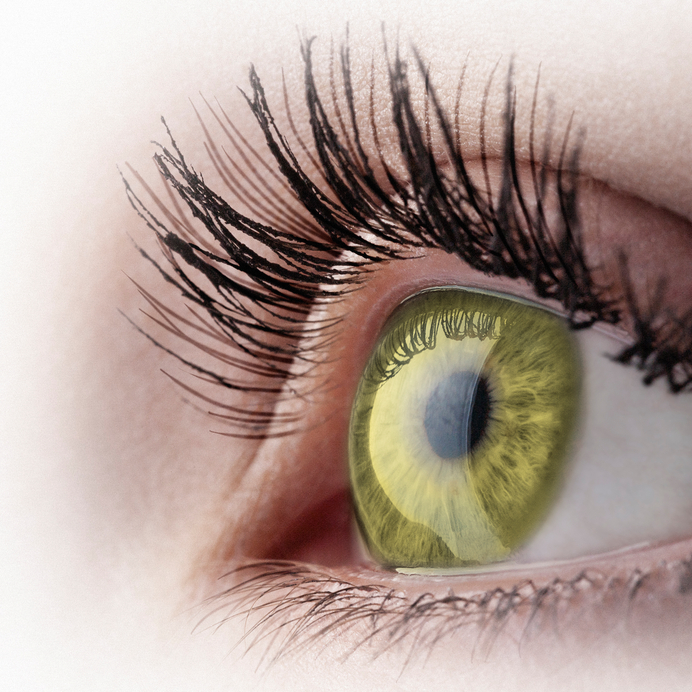
Your glasses do not have to be an eyesore to those around you. Eyeglasses can be a stylish accessory, a part of your personality, or a way for you to be unique. There are a variety of frames to choose from, but you may not know that there are also many ways to improve the appearance of the lenses. Cosmetic tints are now available. These tints offer a variety of colors and shades. You can choose light blue or any other color of the rainbow. Some lenses are clear at the bottom and gradually get more colored towards the top of the lenses. There are many ways to adjust your lenses to whatever style suits your personality. Some tints are also functional.
Recently there has been much attention on a condition called Computer Vision Syndrome, or CVS. A special tint for your glasses can reduce eyestrain associated with CVS.
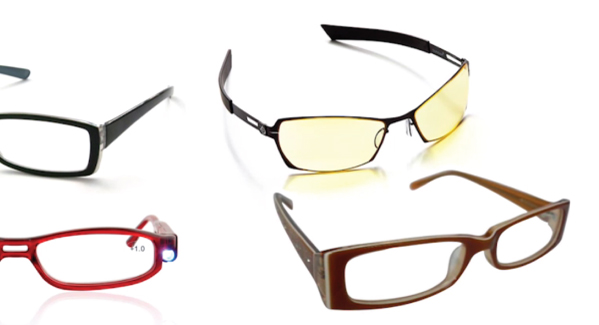
 We all have heard the phrase, “Different strokes for different folks.” Well, this also holds true when it comes to selecting glasses. There are different lenses for just about everybody. No matter what your particular need, there is probably a specialty lens designed for you.
We all have heard the phrase, “Different strokes for different folks.” Well, this also holds true when it comes to selecting glasses. There are different lenses for just about everybody. No matter what your particular need, there is probably a specialty lens designed for you.
For example, a specialty lens that is becoming increasingly useful is designed for computer users. Computer lenses have “windows” designed for viewing your computer screen, documents on your desk, and distant objects. The lenses are designed to reduce Computer Vision Syndrome, or CVS, which is characterized by headaches, eye strain, neck and back aches, dry eyes, blurred vision, and double vision.
Another example is called the double D-segment lens, also known as the double flat-top lens. If you look through most of the lens, you can focus on distant objects. But you can also look through a D-shaped segment near the top of the lens to see nearby overhead objects more clearly. This is very useful if you are involved in work where you are looking at nearby objects above your field of vision, as with carpenters and pilots. The D-shaped segment near the bottom of the lens allows for reading.
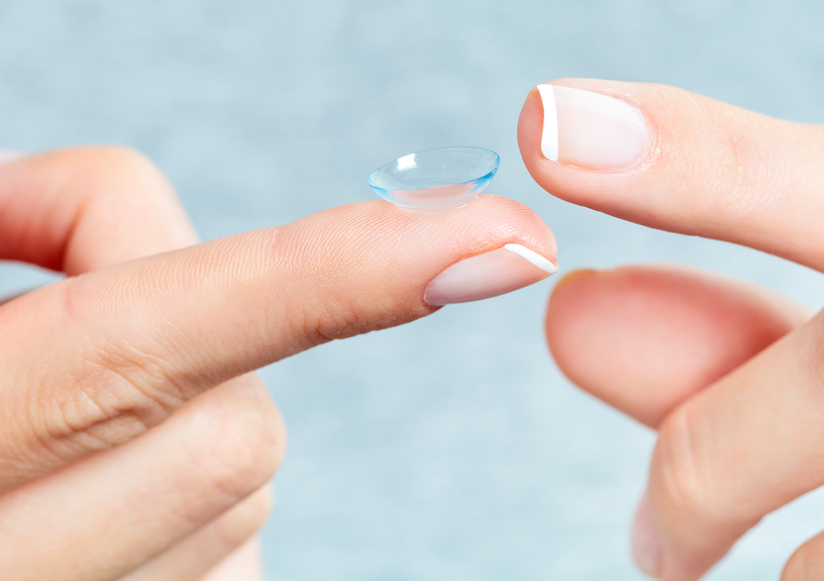
Contact lenses, when used properly, are very convenient, and with the latest advancements in technology, they are extremely comfortable. Most of the time, you will hardly know you are wearing them, though you will certainly notice how clear and accurate your vision is. Contact lenses are small lenses worn on the surface of the eye, or cornea, to correct vision. Lenses are sometimes worn for cosmetic purposes only. We recommend wearing contact lenses in conjunction with eye glasses. This allows you to best meet your overall lifestyle needs while protecting the integrity of your overall eye health.
We will discuss the option that is best for you. Many patients choose contact lenses for their primary vision correction and glasses as a backup option. Many patients who wear glasses have activities and events where they would rather not wear their glasses and they choose contact lenses for these times.
Contact Lens Types
The types of contact lenses available have exploded in the past few years. There are contact lenses available for almost everyone. Many or our patients were told in the past that they could not wear contacts, or they tried unsuccessfully to wear contact lenses. You owe it to yourself to see what is new. We carry many options, and promise to do our best in selecting contact lenses that you will love wearing. Choose from the following list for a brief look at some of the options available.
Soft lenses are very comfortable and come in a variety of types, depending on the wearer’s needs. Conventional soft lenses are worn during the day, and cleaned and stored at night. Usually once a week the lenses must be cleaned using an enzymatic cleaner, which removes protein deposits. These lenses can last for a year or more if your prescription stays the same and you take good care of them.
These lenses are similar to conventional soft lenses except they are replaced more frequently. Oftentimes, they are worn for one-month periods and then replaced. Other frequent replacement soft lens types are worn two to three months before they are replaced. Like conventional soft lenses, they have to be cleaned and stored at night and cleaned once a week with an enzymatic cleaner to remove protein deposits.
Disposable soft lenses are much more popular than conventional soft lenses. These lenses are worn for a period of time and then, of course, thrown away. The most well-known disposables last for two weeks. There are also one-week and one-day disposables. These are perfect for many patients who were told they could not wear contact lenses because of allergies or mild dry eye conditions. They have a low cost per lens and are also popular for athletes and hobbyists who do not necessarily want to wear contact lenses every day.
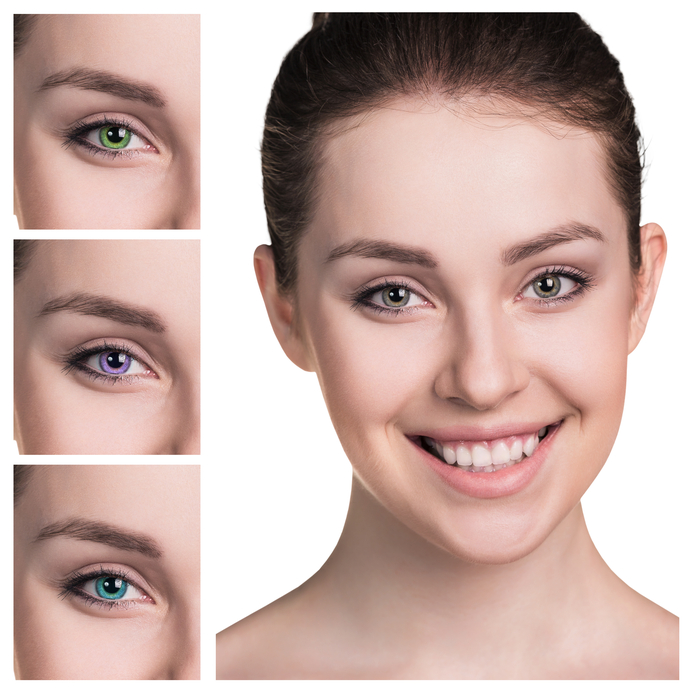
Next, you have tinted soft lenses, available in conventional, disposable, or frequent replacement types. With tinted soft lenses, you can change or enhance your eye color. Even if you do not need corrective lenses, you can use “plano” colored contacts to change your eye color. It is important to be fitted by an eye doctor for colored contact lenses even if you do not need a prescription; wearing the wrong style can damage your eyeball.
Recent technology has greatly improved bifocal soft lenses. Many patients past their 40s who need bifocals can now enjoy the comfort and benefits of soft contact lenses.
Toric lenses are used to correct astigmatism. Astigmatism is a vision condition where an irregularly shaped cornea affects the vision. In the past, the only options for those with astigmatism were either glasses or hard gas permeable contact lenses. But toric lenses, which are lenses with a special shape, now offer an alternative. There are several types of toric lenses to choose from.
Extended wear lenses, the result of new technology in lens materials, transmit more oxygen to the cornea of the eye. Some of these lens materials can be worn up to 30 days, day and night, without removal. Extended wear lenses can last one week, two weeks, or one month, depending upon the lens material and your doctor’s recommendations.
As the name implies, these lenses are hard and gas permeable. If you’ve been told you cannot wear soft lenses, RGP lenses are often a great alternative. RGP lenses are available in specialized designs to correct just about any vision disorder.

There are a variety of solutions available from many different manufacturers. The important thing to remember is that not every solution is right for every type of contact lens. Some contact lenses require the use of multipurpose solutions, while others require separate solutions for the four steps in contact lens care: disinfecting, cleaning, rinsing, and enzyming. Use only the lens solutions that are recommended by the eye doctor. If you wish to change brands, check with our office first.
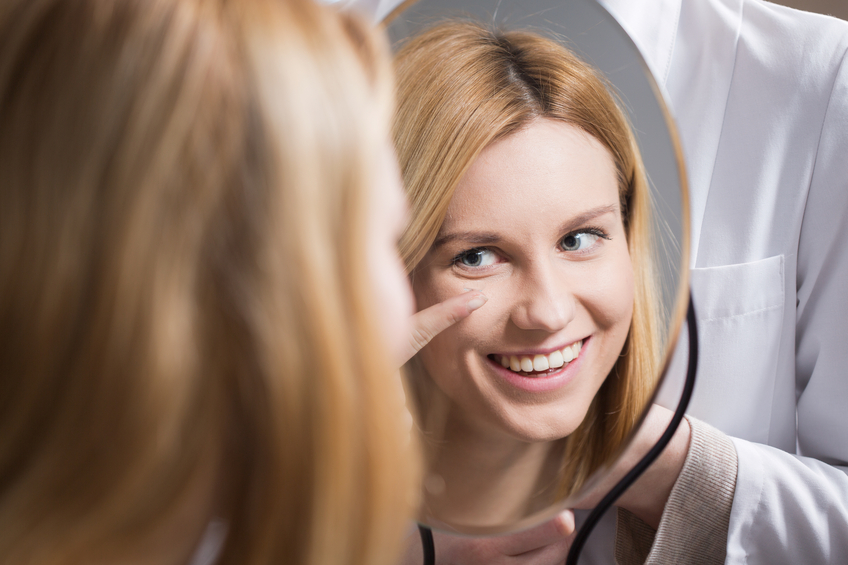
Few things affect the quality of your life more than your eyes--never put them at risk. Contact lenses are prescription medical devices. To make sure your eyes and vision stay healthy while wearing contact lenses, please follow these few guidelines or the instructions recommended by your doctor.
Warning: Ocular complications and/or long-term corneal damage are the consequences of contact lenses that are worn longer than recommended. Oftentimes, your lenses will still feel good even when you are over-wearing them. Do not wear your lenses overnight unless they are approved for extended wear and your doctor has discussed this with you. Overnight wear increases the risk of infection and other complications.
Wearing Schedule
It will take at least a few days for your eyes to get used to wearing contact lenses. The best way to insure maximum visual comfort and keep your eyes healthy is to patiently and faithfully adhere to this wearing schedule.
| Day | Gas Permeable Lenses | Soft Lenses |
|---|---|---|
| 1 | 4 hours | 6 hours |
| 2 | 6 hours | 8 hours |
| 3 | 8 hours | 10 hours |
| 4 | 10 hours | 12 hours |
| 5 | 12 hours | 12 hours |
- DON’T wear your lenses longer than 12 hours a day until your first follow-up visit with your doctor, unless the doctor has specifically told you otherwise.
- DON’T continue use of contact lenses if your eyes become red, irritated, painful, or if your vision gets worse while wearing lenses. Immediately take out the lenses and clean them. Let your eyes get back to normal and if the problem persists, contact our office.
- DON’T exceed the wearing times suggested, even if your lenses still feel comfortable. Studies have proven that the eye needs time to adapt to contact lenses, and your wearing schedule is based on those studies.
- DO always remove your contact lenses at least one hour before going to bed to allow for proper oxygen nourishment to the cornea.
- DO schedule and keep follow-up appointments with your eye doctor.
- DO wear your contact lenses for at least 4 hours the day of your follow-up appointment unless you are experiencing discomfort.
Please Note: If you complete your wearing schedule for a given day and take out your lenses for at least 2 hours, you can wear them the same day for another 2 to 3 hours after cleaning and disinfecting them.
Caring For Your Contacts
Deposits and infectious organisms such as bacteria, viruses--etc., can build up on the surface of all contact lenses. For this reason, it is very important to keep them clean and disinfected.
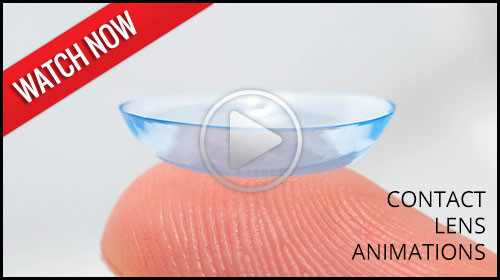
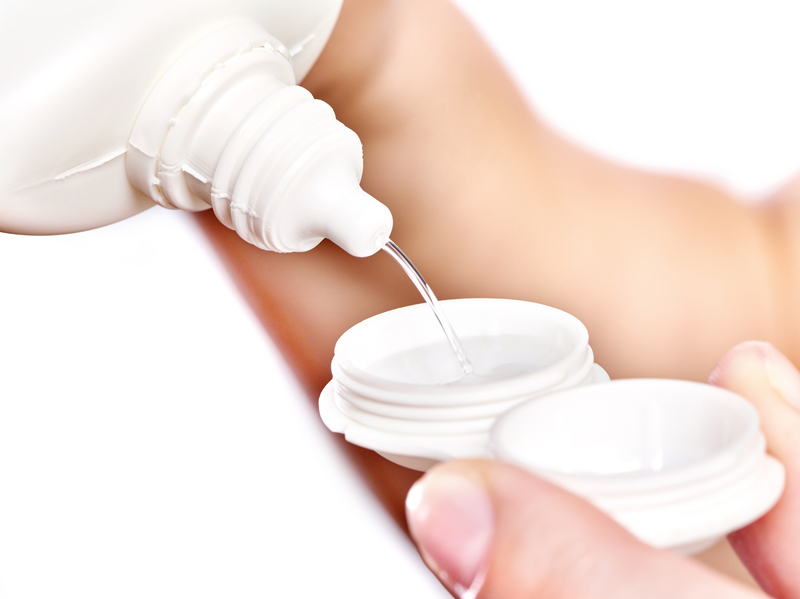 There are four steps in contact lens care--follow the care prescribed for your lenses:
There are four steps in contact lens care--follow the care prescribed for your lenses:
- Cleaning removes dirt, mucous, and other debris that gets on the lenses during wear.
- Disinfecting kills bacteria (germs) on the lenses. Disinfecting is essential to prevent serious eye infections.
- Rinsing removes the other solutions from the lenses and prepares the lenses for wear.
- Enzyming uses enzyme drops or tablets to remove protein and other deposits that build up over time on the lenses.
The best way to properly care for your lenses is to develop a care routine, then stick to that routine! Remember to:
- Follow the directions outlined by your eye doctor. Oftentimes instructions are also listed on the packaging or the package insert for the contact lens solutions prescribed for you.
- Multi-purpose solutions can be used for more than one step in contact lens care. Read the label to see which functions the solutions can be used for.
- Many solutions can not be used together, and not all solutions are appropriate for all types of lenses. Only use solutions recommended by your eye doctor, and check with your eye doctor if you want to switch brands.
- When you remove your lenses, they must be cleaned, rinsed, and disinfected before they are worn again.
- Enzyming and cleaning are not a substitute for disinfecting.
- Lenses that have been stored for more than 12 hours may need to be cleaned, disinfected, and rinsed again.
- Make sure solution containers are kept closed tightly, stored upright, and kept in a clean, dry, cool place when you are not using them. Keep your case clean and replace it every 2-3 months to prevent bacterial growth.
- Don’t touch container bottle tips to any surface to prevent them from becoming contaminated.
- Throw away expired solutions. (Look on the bottle for the expiration date!)
- Use new solution in your contact lenses case every day.
- Discuss with your eye doctor the care for your lenses if you wear them while swimming in a pool or hot tub.
- Only use approved rewetting drops for lubricating or wetting your lenses. Never place the lenses in your mouth.
- Do not use tap water to rinse soft contact lenses.
- Be careful with makeup, lotions, creams and sprays--consider putting on lenses before makeup and remove them before removing makeup. Also, water-based makeup is less likely to damage lenses than oil-based makeup.
Be careful with makeup, lotions, creams and sprays--consider putting on lenses before makeup and remove them before removing makeup. Also, water-based makeup is less likely to damage lenses than oil-based makeup.
Here’s what you need to watch for: Redness, blurriness, light sensitivity. Remove your lenses if you are experiencing any of these 3 things. If your eyes have not returned to normal after 24 hours, please contact our office. If you have any change in vision, comfort, or irritation, immediately remove your lenses. If there is no improvement within a couple of hours, please contact our office.

If you play sports, you should keep two things in mind related to your vision: protection and precision.
Sports lenses protect the wearer’s eyes. Sports such as tennis, baseball, softball, and racquetball may see ball speeds of 90 mph or more. In baseball alone, there are over 500,000 injuries per year! But that is not the most common cause of sports-related eye injuries. Most eye injuries occur in basketball, where an elbow or a finger jabbed into the eye can cause corneal abrasions, fractured bones, retinal detachments, or even blindness. Polycarbonate lenses are more resistant to impact than glass or plastic and offer protection for 90% of eye injuries. Protective eyewear fits well, features a padded bridge, has prescription or non-prescription lenses, and has deep-grooved eyewires to prevent the lens from falling out.
The specialized lenses also optimize your vision. Depending on your sport, certain lenses are more appropriate than others. Dark, UV protection lenses are great for baseball and other outdoor sports. Golfers can benefit from gray-brown colored lenses which make it easier to outline the course. Even if you do not normally wear glasses, non-prescription sports lenses can benefit your performance. Some people think that lenses prevent the wearer from seeing the action, but many sports lenses have anti-fog, glare reduction, and scratch resistant properties. Some are also designed to maximize peripheral vision.

Here at the Eye Care Center, protecting your eyes from harmful UV light rays is a top priority. Eye conditions resulting from sunlight exposure may cause irreversible damage to the back of your eye (called your retina), and it can even cause early cataract formation, which requires surgery.
To reduce exposure to UV rays and their effects, we recommend you invest in a set of sunglasses which can provide at least 98% protection from UVA and UVB rays. While cheaper sunglasses can range from poor to excellent UV protection, our sunwear lines provide the best protection from the sun. At Eye Care Center, we carry College Station’s largest selection of styles and colors.
Our doctors specialize in fitting prescription sunglasses that not only protect your eyes from harmful UV light, but also allow you to stay updated with the latest fashion trends. Polarized lenses are recommended for optimum outdoor vision. For years, boaters and fishermen have used polarized sunglasses to reduce reflected glare from the water surrounding them. But now that many others who spend time outdoors have discovered the benefits of polarized lenses, the popularity of these types of sunglasses has soared.
Besides boaters, outdoor enthusiasts who benefit the most from polarized sunglasses include skiers, golfers, bikers, and joggers, who enjoy a clearer view along with elimination of glare. Polarized sunglasses can also be used indoors by light-sensitive people, including post-cataract surgery patients and those continually exposed to bright light through windows.
Light reflected from surfaces like a flat road or smooth water is generally horizontally polarized. The vertically oriented polarizers in the lenses block this horizontally polarized light.
The result: a reduction in annoying and sometimes dangerous glare.
There is some debate on the effects of polarized lenses on snow-covered surfaces. Some experts say they can reduce the intense glare that is caused by sunlight reflecting off snow. Others report that the lenses are not satisfactory for sports such as downhill skiing because they may not provide the contrast the eye needs to distinguish ice patches or moguls.
In addition, polarized lenses may also react adversely with liquid crystal displays (LCDs) found on the dashboards of some cars or in other places such as the digital screens on automatic teller (bank) machines. The problem with LCDs is that when viewed through polarized lenses from a certain angle, they can be invisible.
Finally, if you have a youngster in the family, it is never too early to fit them with sunglasses. Children under the age of 20 are the most susceptible to the damaging effects of UV light. One concern of parents is that their child will scratch, break, or lose the sunglasses; we are here to help you make the best choice for your child.
Eye Care Center is equipped with a state-of-the-art laboratory and optical dispensary that in most cases can bring you 1-hour service for your glasses! In the day of, “I need them by yesterday,” same day service provides a value to many patients. While we stock single vision polycarbonate lenses for same day service.
For more customized, digital technology we recommend shipping to our dedicated laser-equipped lab. We upgrade your glasses to overnight delivery at no additional cost to you in the event we ship to custom-fit, tailored labs. We specialize in catering to your individual needs for custom glasses such as: computer glasses, golf glasses, motorcycle glasses, safety glasses, and reading, sewing, and/or shooting glasses. Our highly qualified professionals are able to adjust and fit your glasses to you for extended comfort and vision.
Not only do we fabricate your glasses, but we also maintain and repair them should they become broken or damaged. All adjustments are always FREE for the lifetime of your glasses. We also offer free nose pads replacement and deep, professional cleanings. You do not have to be an existing patient to enjoy this free service. Our opticians are dedicated to offering you outstanding quality and service time after time.
Our team of doctors and staff utilize the latest technology to provide you with any frame or lens design available, while keeping abreast of the latest lens innovations. From progressive (no-line) bifocals, to anti-reflective treatments, to polarized sun lenses, to the thinnest and lightest lens materials, we will help you select the lens options that best fit your lifestyle and vision requirements.
Today’s frames come in a wide variety of materials, from the most durable plastics to the almost indestructible titanium. There are also numerous frame styles, from designer fashion frames, to children’s frames, to sun and sport glasses, to special computer relief glasses, all the way to safety frames. Our staff is trained to help you find frames that look great, fit properly, and meet all your vision needs.
Once you have your perfect eyewear, it’s time to ACCESSORIZE! At Eye Care Center, we offer a multitude of items to help you get the most out of your glasses.
Once your purchase your eyeglasses, your optician will explain how to properly care for your lenses, ensuring they don’t scratch or smudge. Dr. Belinda Dobson believes in providing value in this process. For just $5 you can purchase a lens cleaner and get unlimited free refills for an entire year. Stop by anytime we are open for your free refill!
Some prescriptions lend themselves to use convenient over the counter reading glasses. Most glasses you purchase at drug stores or chain stores are not optically inspected and do not offer a premium coating. At Eye Care Center, we can help you select your perfect prescription from a large assortment of colors and styles. Our reading glasses even has a free anti-glare coating to help you on the computer and digital devices.
Whether you are boating, sewing, golfing, or juggling multiple pairs of glasses, we have the cable, cord, or chain for you! Children benefit from proper straps as well, as sometimes in small children frames tend to slip or move down their nose during activities. We even have devices that have floatation features if you are boating and your glasses find themselves in the water! We have you covered at Eye Care Center.
Our frame buddies are back by popular demand in our optical at Eye Care Center. These little animals are popular among children especially, as they hold onto your frames when you are not wearing them. They ensure frames remain in a consistent (and safe) location when not on your child’s face. Don’t forget to ask us about frame buddies at your next appointment at Eye Care Center College Station / Bryan.
Eye Care Center is dedicated to providing the absolute most cutting edge technology available. Dr. Belinda Dobson introduces new technology into our patient care process annually. Next time you visit us, you are certain to be surprised with the newest in technology advancements.
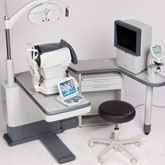
Out with the old, in with the new! At Eye Care Center, Dr. Belinda Dobson uses the TRS-5100, which is Marco's latest generation of digital refraction technology.
Replacing the standard refractor, it allows Dr. Belinda Dobson to control the entire refraction process from a keypad. Do you become anxious about picking from “Which is better, one or two?” With our new technology, this becomes effortless and obsolete. It uses dual imagining so you never have to ‘flip back and forth’ between options! It’s automated and digital, and more accurate than ever before. Come see what you have been missing. See more precise. See more clearly. See the difference.
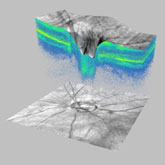
This new high-performance OCT instrument from Carl Zeiss Meditec offers a technological quantum leap forward. Featuring spectral domain technology, Cirrus HD-OCT delivers exquisite high-definition 3-D images of the ocular structures. High Definition data acquisition and advanced analysis provide precise registration and excellent reproducibility critical for glaucoma detection and management.
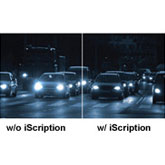
For the first time, experience precision optics with the absolute most high definition lenses available. Experience better night/low-light vision. For example: Looking directly at a light source at night such as car lights, results in glare and halo effects. These are reduced by i-Scription technology.
Experience Better visual contrast. For example: See improved contrast when observing white letters on a black background, which is especially challenging for the eyes. i-Scription technology by Zeiss sharpens contrast.
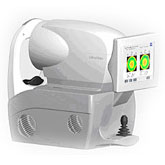
The iProfiler is an instrument designed to determine the exact ‘fingerprint’ of your eyes. This makes it possible to produce Zeiss customized lenses using i.Scription and deliver your best vision possible. Around 1,500 measuring points are used to determine a precise visual profile of your eye. Even the slightest deviations from the ideal shape of the eye can impact your vision. Based on your possible visual profile, we can determine your best prescription possible.
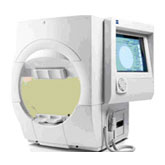
Validated by decades of research and clinical experience, HFA is the accepted standard of care in glaucoma diagnosis and management. HFA has the widest range of testing protocols on any perimeter. The ergonomic design promotes maximum comfort and patient access. It also features screening options that allow Dr. Dobson to screen patients for potential vision problems as part of a thorough eye health assessment.
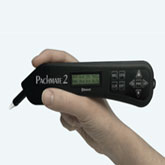
A pachymeter is a medical device that utilizes ultrasound technology to measure the thickness of the eye’s cornea. It is used to perform corneal pachymetry prior to LASIK surgery, for Keratoconus screening, and is useful in screening for patients suspected of developing glaucoma, as well as other corneal diseases. At Eye Care Center, we also utilize pachymetry for the management of an eye condition called Fuch's corneal dystrophy.
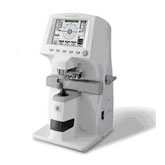
Eye Care Center utilizes lensometry to compare your new prescription to your old glasses. Often patients want to know if their prescription has changed but forget to bring in their old prescription scripts. Lensometry obtains a reading on your old glasses to quantify the changes in refractive error.
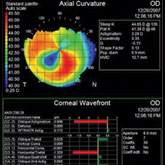
The cornea is the front structure of the eye which serves as the window for your vision. Many times with conditions such as corneal astigmatism, it is difficult to properly fit specialty contact lenses without a more in-depth analysis of the cornea.
Corneal topography allows Dr. Belinda Dobson to map the cornea and successfully fit patients who have previously never been able to wear contact lenses. In addition, corneal topography is used for the diagnosis and management of many eye conditions such as keratoconus, pellucid marginal degeneration, and a host of other rare eye diseases.
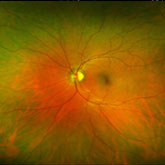
The high definition retinal imaging instrument called Optomap Daytona features state of the art optics which capture a high resolution, panoramic image of your retina, macula, and optic nerve.
The Optomap image facilitates early detection of retinal pathology and other life threatening diseases such as cancer and stroke. The process is quick, painless, and allows your eye doctor to see up to 500% more of the retina than traditional techniques, and often times a dilated pupil exam is not mandatory.

Don’t remember the lessons on eye anatomy from your highschool biology class? That’s OK—we have provided the following eyeball illustration and terms just to give you a refresher course. And we won’t give you a pop quiz afterwards…
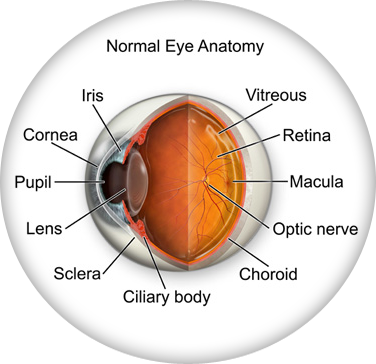
| IRIS | Pigmented tissue lying behind cornea that (1) gives color to the eye, and (2) controls amount of light entering the eye by varying size of black pupillary opening; separates the anterior chamber from the posterior chamber. |
| CORNEA | Transparent front segment of the eye that covers iris, pupil, and anterior chamber, and provides most of an eye's optical power. |
| PUPIL | Variable-sized, circular opening in center of iris; it appears as a black circle and it regulates the amount of light that enters the eye. |
| LENS | Natural lens of eye; transparent intraocular tissue that helps bring rays of light to focus on the retina. |
| SCLERA | The white of the eye; a protective fibrous outer layer covers all of the eyeball except for the part covered by the cornea |
| CILIARY BODY | a muscular ring under the surface of the eyeball; helps the eye focus by changing the len’s shape and also produces aqueous humor |
| CHOROID | The vascular layer between the sclera and the retina; the blood vessels in the choroid help provide oxygen and nutrients to the eye |
| OPTIC NERVE | Largest sensory nerve of the eye; carries impulses for sight from retina to brain |
| MACULA | Small, specialized central area of the retina responsible for acute central vision |
| RETINA | Part of the eye that converts images into electrical impulses sent along the optic nerve for transmission back to the brain. Consists of many named layers that include rods and cones |
| VITREOUS | Transparent, colorless, gelatinous mass; fills rear two-thirds of the interior of the eyeball, between the lens and the retina |
Select from the following list or scroll to learn more about the symptoms and treatments for:
When rays are focused correctly on the retina of a relaxed eye, the eye is said to be emmetropic. Emmetropia is the medical term for 20/20 vision, vision that needs no corrective lenses, contact lenses, or reading glasses. It occurs because the optical power of the eye can perfectly focus an image to the retina, giving it “perfect” vision.
The opposite of emmetropia is ametropia. With ametropia, the focal point of the eye is some distance in front of or behind the retina. The following vision conditions are types of ametropia.
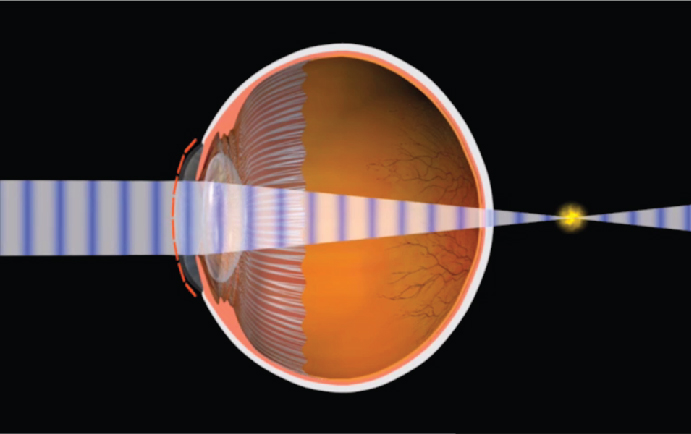
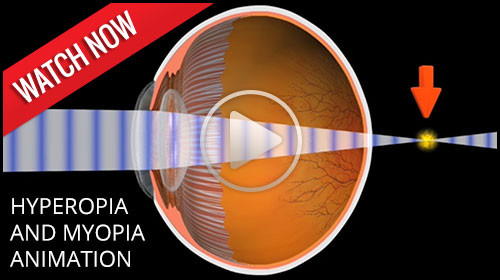 Hyperopia is more commonly known as farsightedness. As the name suggests, people with farsightedness are able to focus on objects that are further away, but have difficulty focusing on objects which are very close. This is because the eyeball is shorter than normal, which prevents the crystalline lens in the eye from focusing correctly on the retina. About a fourth of the population is farsighted. Hyperopia can lead to chronic glaucoma, a more serious condition, later in life.
Hyperopia is more commonly known as farsightedness. As the name suggests, people with farsightedness are able to focus on objects that are further away, but have difficulty focusing on objects which are very close. This is because the eyeball is shorter than normal, which prevents the crystalline lens in the eye from focusing correctly on the retina. About a fourth of the population is farsighted. Hyperopia can lead to chronic glaucoma, a more serious condition, later in life.
A family history of hyperopia is a risk factor for developing hyperopia. Babies are often born with hyperopia but they can usually outgrow the condition as their eyes develop into the correct shape.
Hyperopia can be corrected with eyeglasses or contact lenses. There are also new surgical procedures that can correct hyperopia.
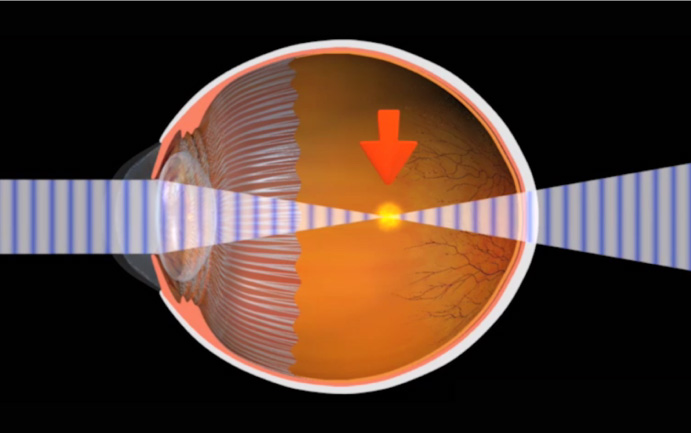
Myopia is the condition of being nearsighted. When it is an inherited condition, myopia begins early in life. People with this condition can usually see near objects, but they struggle to see distant objects. Myopia is the opposite of hyperopia, or farsightedness. In myopia, the anatomy of the eyeball, or globe, is longer than normal. This causes the light to focus in front of the retina, blurring the distance vision. Myopia is corrected with glasses and contact lenses, or with laser vision correction. Laser vision correction is only recommended for people over 18 years old, when the eye has finished growing to adult size.
To correct the symptoms of myopia with glasses, lenses are used that are thicker on the edges and thinner in the middle. This is known as a concave lens, which can be cosmetically improved in higher prescriptions with a high index lens.
Myopes are also at increased risk for a retinal detachment. The signs and symptoms of a retinal detachment are flashing lights, black floaters, or a curtain over the vision. The risk of detachment is typically less than 3 percent.

Amblyopia defined
Amblyopia is also known as lazy eye. It is a condition, usually found in children, in which one or both eyes do not develop properly. An easy way to explain this is that the "eye-brain" connection does not communicate properly; therefore, the child does not know what clear vision is...or what 20/20 vision is. The eye anatomy itself is normal, but the neural pathway to the brain is not normal, causing decreased vision.
Prevalence of amblyopia
Amblyopia is one of the most common treatable forms of vision impairment in children. Its prevalence is as high as 3-5% in some studies. It is most common in infants and young children and it is imperative that this condition is caught early. The chance of successful vision restoration goes down dramatically after age 8, therefore the earlier this condition is caught the better chance of successful treatment.
Causes of amblyopia
The causes of amblyopia are varied. A very common condition that can cause amblyopia is strabismus, a misalignment of the eyes. This occurs when one eye has an abnormal turning in or out, causing the brain to stop using the misaligned eye. Other causes may come from a high prescription such as nearsightedness, farsightedness, or astigmatism. In the case of these conditions, the eye’s vision is out of focus and so the brain turns off that image. Eye disease processes can also cause amblyopia. One of these conditions is known as a cataract. A cataract is a condition of the lens of the eye developing an opacity so that light cannot pass through. Abnormal retinal conditions and hereditary factors can also cause amblyopia.
Treatment of amblyopia
 In order to increase the chances for success, this condition must be detected early. The recommended ages for early eye examination are 6 months old, then 2-3 years of age, and then school age.
In order to increase the chances for success, this condition must be detected early. The recommended ages for early eye examination are 6 months old, then 2-3 years of age, and then school age.
Patching, or occlusion therapy
One of the most common treatments for amblyopia is patching, also known as occluding, the better or stronger eye. This forces the brain to use the weaker eye. An adhesive eyepatch on the skin or a slip-on patch over glasses can be incorporated for occlusion therapy. A blurring contact lens or dilating eye drop can also be used to occlude the good eye.
Surgery
Cataract, eye muscle, or retinal surgery can be incorporated to help treat the underlying cause of amblyopia in some cases.
Vision therapy
Vision therapy has been proven to be successful in the treatment of amblyopia. Vision therapy, or VT, incorporates a series of vision training procedures that helps improve eye movement control, visual acuity, depth perception, and eye coordination. Vision therapy can be done in an office or home setting.
Signs and symptoms of Amblyopia
The most common way amblyopia is diagnosed is a detection of a decreased red reflex in the child's eye. A diagnostic instrument used by the optometrist, ophthalmologist, or pediatrician, can pick up a bright reflection in the normal eye and a dim reflection in the amblyopic eye. Upon further examination, the eye is dilated to see if a refractive error of myopia, astigmatism, or hyperopia is the cause.
Another sign of amblyopia is an eye that turns in or out. A symptom that may be indicative for amblyopia is if the child prefers the vision out of one eye. This can sometimes be detected when occluding the better eye--the child may become fussy and upset because she cannot see out of the lazy eye.
Citations:
1. Amblyopia informational patient brochure. APOS.org. January 2013

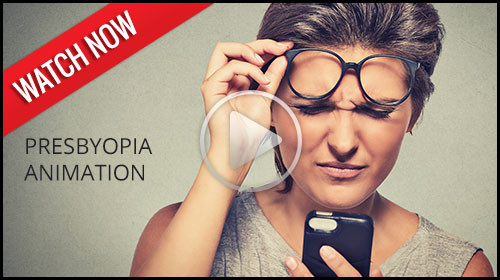 As people get older, usually when they hit their 40s, a condition called presbyopia can set in. Presbyopia is the inability to focus on objects near the eye. One usually notices that it is harder to read or use the computer. Bifocals or reading glasses are a way to remedy this condition.
As people get older, usually when they hit their 40s, a condition called presbyopia can set in. Presbyopia is the inability to focus on objects near the eye. One usually notices that it is harder to read or use the computer. Bifocals or reading glasses are a way to remedy this condition.
Presbyopia is a natural consequence of the aging process. There is no known cure, though researchers are constantly looking for one. Even if someone has never had vision problems before, he can still develop presbyopia. It may seem to occur suddenly, but it actually occurs over a long period of time. Symptoms include having to hold things at arm’s length to see them clearly, eye strain, fatigue, and headaches from near work.
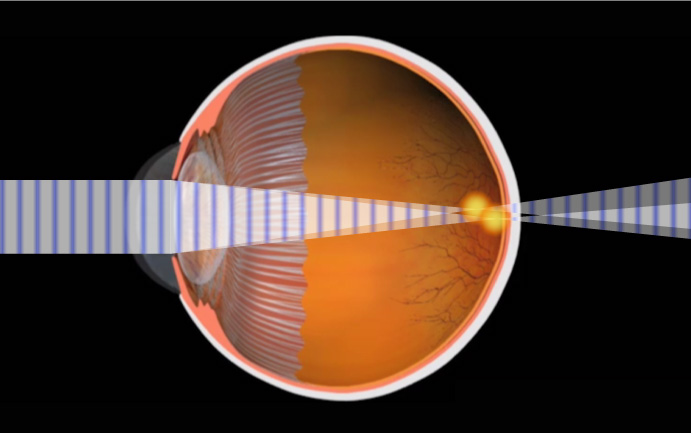
 Sometimes the cornea is irregularly shaped, causing the eye to focus an object on two different areas of the retina. This is known as astigmatism. For the cornea to bend light correctly, it should be dome-shaped, like a basketball. Astigmatic corneas are shaped more like a football. This causes a distorted view when looking at objects which are close-up and far away.
Sometimes the cornea is irregularly shaped, causing the eye to focus an object on two different areas of the retina. This is known as astigmatism. For the cornea to bend light correctly, it should be dome-shaped, like a basketball. Astigmatic corneas are shaped more like a football. This causes a distorted view when looking at objects which are close-up and far away.
The cause of astigmatism is unknown. Astigmatism is often associated with myopia or hyperopia, and it usually is present from birth. It may be hereditary, or it may be caused by factors such as pressure on the cornea, incorrect posture, or increased use of the eyes for “near work.”
Mild astigmatism usually does not need to be corrected. Eyeglasses, contact lenses, or refractive surgery can correct moderate to high degrees of astigmatism.

 Computer vision syndrome (CVS) affects three out of four computer users. It is a series of symptoms related to extended periods of computer usage. Though it is no cause for panic, measures can be taken to relieve symptoms of CVS.
Computer vision syndrome (CVS) affects three out of four computer users. It is a series of symptoms related to extended periods of computer usage. Though it is no cause for panic, measures can be taken to relieve symptoms of CVS.
Symptoms
CVS can appear as a variety of symptoms. Headaches, eye strain, neck and back aches, sensitivity to light, blurred vision, double vision, and dry or irritated eyes are all possible problems related to CVS.
Risk Factors
Any computer user can develop CVS. Your vision, your computer, and the environment where you use your computer are all factors which can lead to CVS.
Our top priority is the care of your eyes. We want to keep your eyes healthy through regular eye health evaluations, communication, and education. This page lists a few of the most common eye diseases. Select from the following list of topics or scroll to learn about the causes, symptoms, and treatments for:
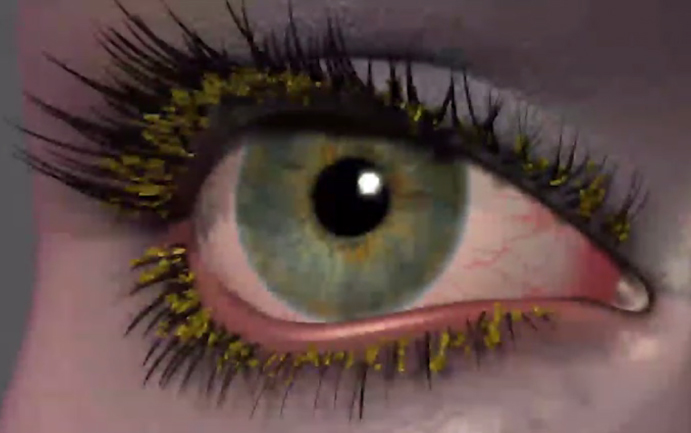
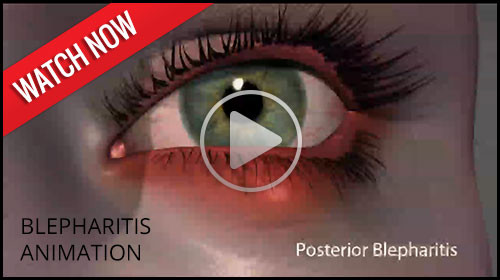 There are two types of blepharitis. Seborrheic blepharitis is often part of an overall skin condition called seborrhea, which may also affect the scalp, chest, back and the area behind the ears. The second form of blepharitis – staph blepharitis – is a more severe condition, caused by bacteria, that begins in childhood and may continue through adulthood.
There are two types of blepharitis. Seborrheic blepharitis is often part of an overall skin condition called seborrhea, which may also affect the scalp, chest, back and the area behind the ears. The second form of blepharitis – staph blepharitis – is a more severe condition, caused by bacteria, that begins in childhood and may continue through adulthood.
Causes
Hormones, nutrition, general physical condition, and even stress may contribute to seborrheic blepharitis. Build-ups of naturally occurring bacteria contribute to staph blepharitis.
Symptoms
Blepharitis could be described as dandruff of the eyelids. Seborrheic blepharitis results in redness of the eyelids, flaking and scaling of eyelashes, and greasy, waxy scales caused by abnormal tear production. Staph blepharitis can cause small ulcers, loss of eyelashes, eyelid scarring, and even red eye.
Treatment
Careful cleaning of the eyelids can reduce seborrheic blepharitis. Application of hot packs to the eyes for 20 minutes a day can also help. Staph blepharitis may require antibiotic drops and ointments.

 A cataract is an opacity of the lens of the eye. The body's natural lens is similar to an onion, with many layers. These layers contain protein and as the proteins clump together, they cover the lens and make it difficult to see clearly. Cataracts are generally seen in the older population, but they can occur at any age, even birth. By age 60, over half of the population has some symptoms of cataracts due to the natural aging process.
A cataract is an opacity of the lens of the eye. The body's natural lens is similar to an onion, with many layers. These layers contain protein and as the proteins clump together, they cover the lens and make it difficult to see clearly. Cataracts are generally seen in the older population, but they can occur at any age, even birth. By age 60, over half of the population has some symptoms of cataracts due to the natural aging process.
Cataracts are painless but if left untreated can lead to blindness. Cataract surgery is done on an outpatient basis with little or no downtime afterwards. The surgery is performed by a medical doctor known as an ophthalmologist, who specializes in surgery of the eye. The aftercare or postoperative care can be administered by an ophthalmologist or an optometrist.
Symptoms of Cataracts
There can be a myriad of symptoms when a person develops a cataract. It is common for vision to be blurry, as though you are looking through a foggy window. Color vision changes occur in which the brightness of colors fade, especially blue and green. Patients with cataracts also experience difficulty in reading small print. They also feel like they need brighter light or possibly a new glasses prescription. Double vision or vision that seems like halos around the letters also occurs, as well as sensitivity to light.
Causes of Cataracts
The exact physiological cause of cataracts is unknown, but there are many risk factors. Aging and trauma are known to cause cataracts. A blunt trauma or injury to the eye can cause a cataract at any age. The effect of aging on the cells of the lens contributes to cataracts usually after age 60. There is also a direct correlation between the sun's UV rays and certain radiation exposures that contriibute to cataract growth. Smoking is a big risk factor for developing cataracts as well.
Poor nutrition can add to the risk of developing cataracts. Lack of vitamin C has been shown to increase the genesis of cataract formation. Some prescription medicines, especially prednisone, can cause cataracts. Diabetes and other chronic disease processes are also factors in cataract formation. Finally, there are genetic factors that contribute to a cataract.
Treatment of Cataracts
The standard of care for the treatment of cataracts is typically surgery. Cataract surgery, which is an outpatient procedure, removes the protein accumulation from the eye by replacing the cloudy natural lens with an artificial lens. This artificial lens, known as an IOL or intraocular lens, will have your prescription, which in most cases, makes you less dependent on glasses. Lens technology has evolved over the years to also accommodate prescriptions for astigmatism and bifocal prescriptions. Cataract surgery is one of the most commonly performed surgeries in the United States, and it has a success rate of over 98%.
There are many types of cataracts that form on the eye, with different levels of density. This can affect the post-operative care of cataract patients. After cataract surgery, it might be necessary to use a laser to clear an after-cataract membrane that can occur weeks to months after the procedure. This treatment uses a YAG laser and is a painless, low risk, in-office procedure. Most patients can return to work or normal activities within days after the procedure. Your doctor will likely prescribe eyedrops to prevent infection and swelling.
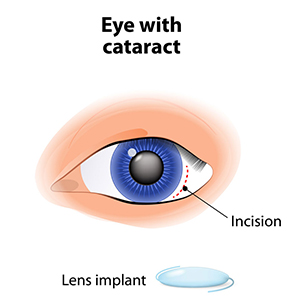
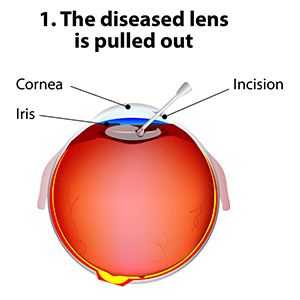
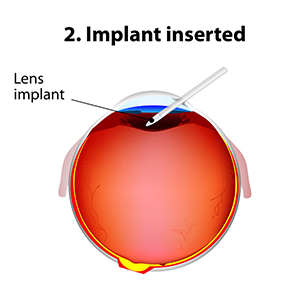
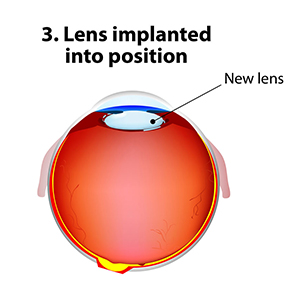
Recent Findings
New technology in cataract surgery includes a bladeless customized procedure that allows for faster healing and clearer vision after the procedure. This computer assisted surgery uses a laser to make the incisions. The laser also divides the cataract efficiently so that the surgeon can remove the old lens and replace it with a new state-of-the-art IOL ( Intraocular lens). This technology uses a femtosecond laser which emits cool pulses of energy. This technology has been used for decades in LASIK surgery for the correction of myopia or nearsightedness. This form of cataract surgery now allows the procedure to be more precise, and reproducible.
Citations
1. What is a cataract? Educational website release. Triadeye.com. January 13, 2013.
2.Bladeless cataract laser surgery. LenSX press release. October 4, 2012.

Conjunctivitis, commonly called pink eye, is a redness of the eye. It is often accompanied by a discharge (clear, yellow, or white) and itching in the eye.
Causes
Pink eye is most often a viral infection, but it can also be caused by bacteria or an allergic reaction. Viral pink eye is highly contagious.
Prevention and Treatment
To avoid spreading conjunctivitis, wash your hands often, do not touch the infected area with your hands, do not share washcloths or towels, and avoid using makeup which may become contaminated. A child with pink eye should be kept from school for a few days. Sometimes an eye doctor will need to prescribe antibiotic eye drops and ointments to clear up conjunctivitis.

 Diabetic retinopathy is a condition associated with diabetes. High levels of blood sugar may damage tiny blood vessels in your eye. New vessels may form to replace the damaged vessels. The new vessels can burst, resulting in blurred vision or even blindness.
Diabetic retinopathy is a condition associated with diabetes. High levels of blood sugar may damage tiny blood vessels in your eye. New vessels may form to replace the damaged vessels. The new vessels can burst, resulting in blurred vision or even blindness.
Symptoms
Symptoms of diabetic retinopathy include:
- "Floaters” – small specks that pass across your field of vision, made up of cells floating in the transparent gel of your eyeball
- Difficulty reading or seeing things close-up
- Sudden loss of vision
- Flashes
- Blurred or darkened vision
Risk Factors and Treatment
If you have diabetes, make sure you control your blood sugar level. This will reduce your risk of getting diabetic retinopathy. If you are experiencing some of the symptoms listed above, give us a call. If diagnosed properly, diabetic retinopathy can be treated with a laser procedure or a vitrectomy.

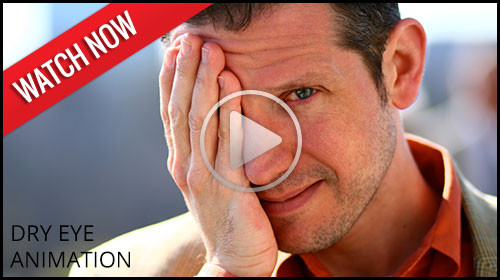 If your eyes are constantly itchy or dry, you may have dry eye syndrome, which affects many millions of Americans. Dry eye syndrome is caused by a lack of, or poor quality of, tears. Tears lubricate the outer layer of the eye called the cornea. If the tears are not adequate or are not composed of a proper balance of mucous, water, and oil, the eye becomes irritated.
If your eyes are constantly itchy or dry, you may have dry eye syndrome, which affects many millions of Americans. Dry eye syndrome is caused by a lack of, or poor quality of, tears. Tears lubricate the outer layer of the eye called the cornea. If the tears are not adequate or are not composed of a proper balance of mucous, water, and oil, the eye becomes irritated.
Symptoms
Dry eye syndrome leads to a number of symptoms, including itchiness, irritation, burning, excessive tearing, redness, blurred vision that improves with blinking, and discomfort after long periods of watching television, using a computer, or reading.
Risk Factors
There are many factors that can contribute to dry eye syndrome. These include dry, hot, or windy climates; high altitudes; air-conditioned rooms; and cigarette smoke. Contact lens wearers, people with abnormally dry skin, and the elderly are more likely to develop dry eye syndrome. You may also be more at risk if you take certain medications, have a thyroid condition, a vitamin-A deficiency, Parkinson’s or Sjorgen’s disease, or if you are a woman going through menopause.

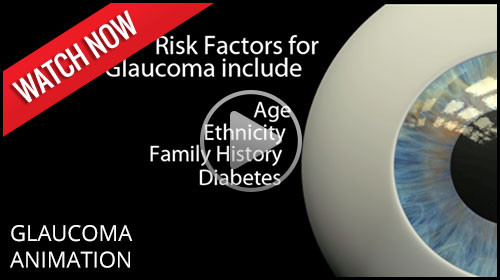 Glaucoma is a serious sight-threatening condition in which there is an abnormal pressure inside the eye. Typically, the pressure or IOP (intraocular pressure) is too high for the blood vessels and optic nerve to function normally, leading to loss of vision.
Glaucoma is a serious sight-threatening condition in which there is an abnormal pressure inside the eye. Typically, the pressure or IOP (intraocular pressure) is too high for the blood vessels and optic nerve to function normally, leading to loss of vision.
There are some forms of glaucoma that can occur with normal pressure in the eye. The average IOP for a healthy eye is 10 to 22 mm of Mercury. Just as a physician’s office tests your blood pressure annually, the eye doctor tests your IOP during annual eye examinations.
Types of Glaucoma
There are several varieties of the disease, with primary open-angle glaucoma being the most common. Primary open-angle glaucoma (POAG) occurs when the IOP is higher than normal. As the pressure increases, it destroys vital nerve tissue that is irreparable. POAG usually occurs over a long period of time, months to years, and slowly causes peripheral visual field loss. If left untreated, a sufferer progresses to tunnel vision and then to total blindness.
A second type of glaucoma is acute-angle closure. This is considered a medical emergency because the interocular pressure spikes suddenly to anywhere from 30-70 mm or higher. This causes extremely sharp pain, nausea and vomiting, and cloudy vision. The IOP needs to be lowered within hours to prevent permanent vision loss.
Juvenile open-angle glaucoma, or JOAP, is similar to POAG, in that is causes a gradual visual field loss. The most common form is in children from ages 3 to 21. Infantile or congenital glaucoma is a type of glaucoma that manifests itself between birth to 3 years of age. A typical sign is an enlarged bluish-gray cornea, the front dome of the eye. Excessive tearing of the eye and sensitivity to light are also symptoms. Finally, secondary glaucoma is caused from trauma, eye disease, or certain medications.
Causes of Glaucoma
Many theories on the cause of glaucoma exist, but the exact cause is unknown. Glaucoma can be a hereditary condition. It also can be caused by malformed anatomical structures in the eye. Certain risk factors such as hyperopia and cataracts cause a higher incidence of certain types of glaucoma.
One cause of glaucoma is an insufficient drainage system of the aqueous fluid. The aqueous imbalance causes a gradual buildup of pressure which destroys vision. Another cause is an insufficient flow of blood to the optic nerve. Ocular trauma or injury that damages the anterior segment for the lens and drainage mechanism of the eye can also lead to glaucoma. In the case of normal tension glaucoma, pressure readings are in the normal range. The cause of this is unknown.
Treatment
Even though in most cases there is no way to prevent glaucoma, there are many treatment options. Medications in the form of eyedrops are commonly prescribed. Different combinations of agents act on mechanisms of action to lower IOP or to slow the production of fluid.
Advanced surgical and laser procedures can also be viable options for the treatment of glaucoma. An in-office procedure called laser trabeculoplasty can cause the meshwork in the eye to work more efficiently. This treatment has a temporary effect and may need to be done multiple times. Another effective surgery uses a drainage implant to facilitate better outflow and inflow of aqueous fluid in the eye. These procedures help keep the pressure stabilized. Conventional surgery for glaucoma is done in an operating room scenario. A flap in the eye is created to facilitate outflow of the pressure. This pressure-controlling surgery is known as a trabeculotomy.
Furthermore, some oral medications can also be used in the treatment of glaucoma.
Methods of Testing for Glaucoma
During a comprehensive eye examination, eye pressure can be tested through various methods. Tonometry gives a pressure reading of the eye. A tomometer has different methods such as a probe that gently touches the front of the eye after the eye doctor has administered anesthetic eyedrops. Another method of testing uses a puff of air. For children, there is a tonometer that is quick and does not require anesthesia.
A pachometer, which measures the thickness of the front of the eye called the cornea, can also aid in diagnosis. A visual field device can measure for early or late damage in the peripheral fields of vision. Lastly, newer technology called OCT, or optical coherence tomography, counts the nerve fibers, which can help detect early changes in the disease.
Prevalence of Glaucoma
There are approximately 3 million individuals in the United States with glaucoma. It is the second leading cause of blindness in the country. Most cases are found in the population over age 40, and more women than men have the disease. Two thirds of glaucoma cases are in the Caucasian population, approximately 20% are African-American, and 10% are Hispanic. Glaucoma continues to rise every year in the population.
The key to success in the treatment of glaucoma is early detection and progressive monitoring of the condition. Comprehensive eye examinations and diligent monitoring will help protect from vision loss with this disease.
Citations
- Glaucoma. AOA pdf. AOA.org.
- I Care Tonometry in Children. JAAPOS. Sciencedirect.com. April 2011
- Glaucoma, open -angle. NEI source press release. 2010.

 Macular degeneration is a disease which affects a small area of the retina known as the macula. The macula is a specialized spot on the retina that allows us to see the fine detail of whatever is directly in front of us. Macular degeneration occurs when the macula begins to deteriorate.
Macular degeneration is a disease which affects a small area of the retina known as the macula. The macula is a specialized spot on the retina that allows us to see the fine detail of whatever is directly in front of us. Macular degeneration occurs when the macula begins to deteriorate.
“Wet” vs. “Dry”
Most often, macular degeneration is accompanied by formation of yellow deposits, called “drusen,” under the macula, which dry out or thin the macula. This is called “dry” macular degeneration. In rare cases, abnormal blood vessels develop under the macula and leak fluid. This is called “wet” macular degeneration.
Causes
A number of uncontrollable factors contribute to macular degeneration, including age, sex, eye color, farsightedness, and race. Risk factors you can control include smoking, high blood pressure, exposure to harmful sunlight, and diet.
Symptoms
It is difficult to detect dry macular degeneration in its early stages. The most common symptoms, when detected, include a spot of blurry vision, dark vision, or distorted vision. Wet macular degeneration progresses much faster than the dry variety. Both forms of macular degeneration can cause blindness.
Treatment
Currently, there is no cure for macular degeneration, but treatment is available to slow the effects.
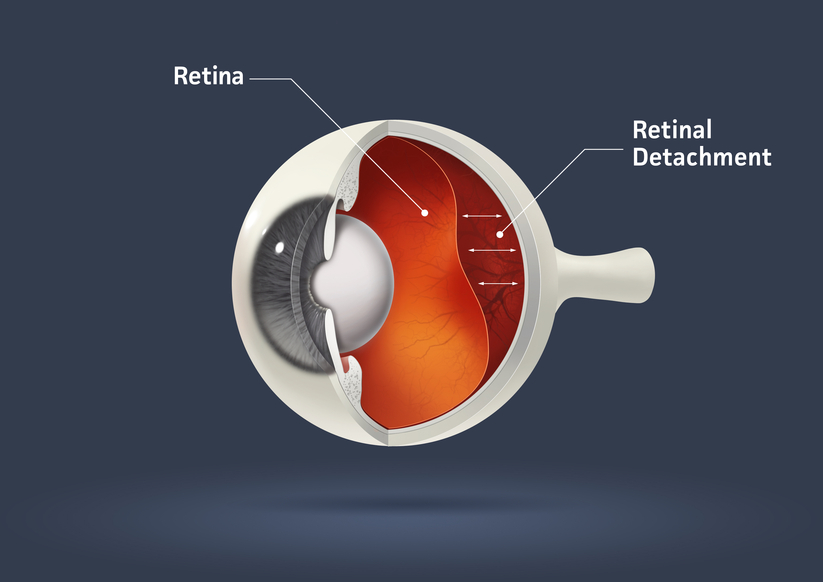
The part of the eye which collects light and transmits the light messages to the optic nerve and brain is the retina. It lines the inner back wall of the eye. When the retina separates from the back wall, it is known as retinal detachment. It is a serious condition which can cause permanent damage and vision loss if not treated quickly.
Symptoms
A retinal detachment often causes sudden defects in your vision. It may just cause a blind spot too small to notice, or it may cause a noticeable shadow which obscures your vision. An increase in “floaters,” which look like small particles or fine threads, may also be noticed. Finally, flashes of light are associated with retinal detachment.
Risk Factors
Eye injuries, tumors, and cataract surgery can cause retinal detachment. Nearsighted individuals and the elderly are at greater risk for spontaneous detachment. Also, diabetic retinopathy, a condition associated with diabetes, can cause bleeding which leads to retinal detachment.

Presbyopia is a Latin term for "old man eyes." This condition actually begins in your late 20s and slowly causes close vision loss. Most people develop symptoms after age 35--these symptoms include eyestrain and blurry vision while reading. Often presbyopia causes people to push objects further away to view them clearly. The treatment for presbyopia includes glasses and contact lenses, laser procedures, and other surgical procedures.
Reading glasses, bifocals, trifocals, or progressive multifocal blended lenses are all options to treat and correct presbyopia with glasses.
Soft, rigid, gas permeable, or a combination of these materials can treat presbyopia with contact lenses. Many surgical and laser techniques are used to treat presbyopia with new technology developing every year for this emerging population.
 To reduce eye strain and fatigue, we carry specialized computer lenses. These lenses are perfect for computer users who spend a majority of their days working on computers. And since three out of four computer users will suffer from Computer Vision Syndrome, computer lenses are a great way to keep your eyesight healthy.
To reduce eye strain and fatigue, we carry specialized computer lenses. These lenses are perfect for computer users who spend a majority of their days working on computers. And since three out of four computer users will suffer from Computer Vision Syndrome, computer lenses are a great way to keep your eyesight healthy.
One of the first areas of your life where presbyopia becomes prominent is in your ability to read. There are a variety of styles available, with sleek designs that allow you to carry them anywhere.
For many presbyopes, bifocal lenses are a necessity. But it can be difficult to adjust to the harsh line that is found in many bifocal lenses. Fortunately, there are no-line lenses, which are also called progressive lenses. No more lines! Just a change in focusing power which allows you to comfortably focus on any distance. Just as with lined bifocals, distant objects are viewed through the top portion of the lenses, and near objects are viewed through the bottom portion of the lenses.
If you need bifocals but cannot stand wearing glasses, you may need bifocal contact lenses. Now you can have all of the benefits of bifocal lenses in the convenience of contact lenses. Talk with your doctor about bifocal contacts today.
For some of our emerging presbyopes we offer another option to glasses. Monovision is a method of fitting your dominant eye for distance vision and your non-dominant eye for near vision. Contacts are available in disposable, extended wear, and even daily disposable lenses to fit your lifestyle. Most patients require 2-4 weeks to make the adjustment from binocular vision to monovision.
Children with uncorrected vision conditions or eye health problems face many barriers in life, academically, socially, and athletically. High-quality eye care can break down these barriers and help enable your children to reach their highest potential. As a parent, make sure you are giving your children the eye care they need. Presented are guidelines from the American Optometric Association.

Your baby has a whole lifetime to see and learn. But did you know your baby also has to learn to see? As a parent, there are many things that you can do to help your baby’s vision develop.
When your baby is about six months, you should take him to your doctor of optometry for his first thorough eye examination. Things that the optometrist will test for include excessive or unequal amounts of nearsightedness, farsightedness, astigmatism, lack of eye movement ability, as well as other eye health problems. These problems are not common, but it is important to identify children who have them at this stage. Vision development and eye health problems can be more easily corrected if treatment is begun early.
Unless you notice a need, or your doctor of optometry advises you otherwise, your child’s next eye exam should be around age three, and then again before he or she enters school.
During the first four months of life, your baby should begin to follow moving objects with the eyes and to reach for things, first by chance and later more accurately, as hand-eye coordination and depth perception begin to develop.
To help, use a nightlight or other dim lamp in your baby’s room; change the crib’s position frequently and your child’s position in it; keep reach-and-touch toys within your baby’s focus, about eight to twelve inches from his eyes; talk to your baby as you walk around the room; alternate right and left sides with each feeding; and hang a mobile above and outside the crib.
Between four and eight months, your baby should begin to turn from side to side and use her arms and legs. Eye movement and eye/body coordination skills should develop further and both eyes should focus equally.
Enable your baby to explore different shapes and textures with his or her fingers; give your baby the freedom to crawl and explore; hang objects across the crib; and play “patty cake” and “peek-a-boo” with your baby.
From eight to twelve months, your baby should become mobile, crawling and pulling himself or herself up. He or she will begin to use both eyes together to judge distances and grasp and throw objects with greater precision. To support development do not encourage early walking – crawling is important in developing eye-hand-foot-body coordination; give your baby stacking and take-apart toys; and provide objects your baby can touch, hold and see at the same time.
From one to two years, your child’s eye-hand coordination and depth perception will continue to develop and he or she will begin to understand abstract terms. Things you can do are to encourage walking; to provide building blocks, simple puzzles and balls; and to provide opportunities to climb and explore indoors and out.
There are many other affectionate and loving ways in which you can aid your baby’s vision development. Use your creativity and imagination. Ask your doctor of optometry to suggest other specific activities.

During the infant and toddler years, your child has been developing many vision skills and has been learning how to see. In the preschool years, this process continues as your child develops visually guided eye-hand-body coordination, fine motor skills, and the visual motor skills necessary to learn to read.
As a parent, you should watch for signs that may indicate a vision development problem, including a short attention span for the child’s age; difficulty with eye-hand-body coordination in ball play and bike riding; avoidance of coloring and puzzles and other detailed activities.
There are everyday things that you can do at home to help your preschooler’s vision develop as it should.
These activities include reading aloud to your child and letting him or her see what you are reading; providing a chalkboard, finger paints and different shaped blocks and showing your child how to use them in imaginative play; providing safe opportunities to use playground equipment such as a jungle gym and balance beam; and allowing time for interacting with other children and for playing independently.
By age three, your child should have a thorough optometric eye examination to make sure your preschooler’s vision is developing properly and there is no evidence of eye disease. If needed, your doctor can prescribe treatment including glasses and/or vision therapy to correct a vision development problem.
Here are several tips to make your child’s optometric examination a positive experience:
- Make an appointment early in the day. Allow about one hour.
- Talk about the examination in advance and encourage your child’s questions.
- Explain the examination in your child’s terms, comparing the E chart to a puzzle and the instruments to tiny flashlights and a kaleidoscope.
Unless recommended otherwise, your child’s next eye examination should be at age five. By comparing test results of the two examinations, your optometrist can tell how well your child’s vision is developing for the next major step. . .the school years.

A good education for your child means good schools, good teachers and good vision. Your child’s eyes are constantly in use in the classroom and at play. So when his or her vision is not functioning properly, learning and participation in recreational activities will suffer.
The basic vision skills needed for school use are:
- Near Vision. The ability to see clearly and comfortably at 10-13 inches.
- Distance Vision. The ability to see clearly and comfortably beyond arm’s reach.
- Binocular coordination. The ability to use both eyes together.
- Eye movement skills. The ability to aim the eyes accurately, move them smoothly across a page and shift them quickly and accurately from one object to another.
- Focusing skills. The ability to keep both eyes accurately focused at the proper distance to see clearly and the ability to change focus quickly.
- Peripheral awareness. The ability to be aware of things located to the side while looking straight ahead.
- Eye/hand coordination. The ability to use the eyes and hands together.
If any vision skills are lacking, your child will have to work harder. This can lead to headaches, fatigue, and other eyestrain problems. As a parent, be alert for symptoms that may indicate your child has a vision or visual processing problem. Be sure to tell your optometrist if your child frequently:
- Loses his place while reading.
- Avoids close work.
- Holds reading material closer than normal.
- Tends to rub his eyes.
- Has headaches.
- Turns or tilts head to use one eye only.
- Makes frequent reversals when reading or writing.
- Uses finger to maintain place when reading.
- Omits or confuses small words when reading.
- Consistently performs below potential.
Since vision changes can occur without you or your child noticing them, your child should visit the optometrist at least every two years, or more frequently if specific problems or risk factors exist. If needed, the doctor can prescribe treatment including eyeglasses, contact lenses, or vision therapy.
Remember, a school vision or pediatrician’s screening is not a substitute for a thorough eye examination.
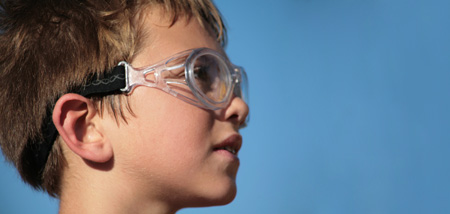
Never overlook the importance of safety eyewear when playing sports. Every year, hundreds of men, women, and children are injured while playing sports. To help prevent sports-related eye injuries, athletes should use protective athletic eyewear whether or not prescription eyewear is needed. One choice is a sports frame with prescription or non-prescription polycarbonate lenses. Baseball or softball players who are hit in or near the eye, or suffer a blow to the head, should seek immediate care at a hospital emergency room or from an eye care professional.
The important thing to remember for parents of children who wear contact lenses is that contacts are prescribed medical devices. Contact lenses are not a cosmetic accessory. While the wearer may be happy about his or her new look, it is extremely important that the lenses be properly cleaned and worn according to the instructions of the optometrist.
- My Child Is Near-Sighted. Will Glasses Correct His/Her Learning Problem?
- What Is the Relationship between Eye Muscle Problems and Learning?
- My Child Loses His/Her Place. Is That Related to the Eyes?
- My Child Reverses Letters and Words. Does He See Backwards?
- What Are the Other Visual Components Necessary for Academic Achievement?







